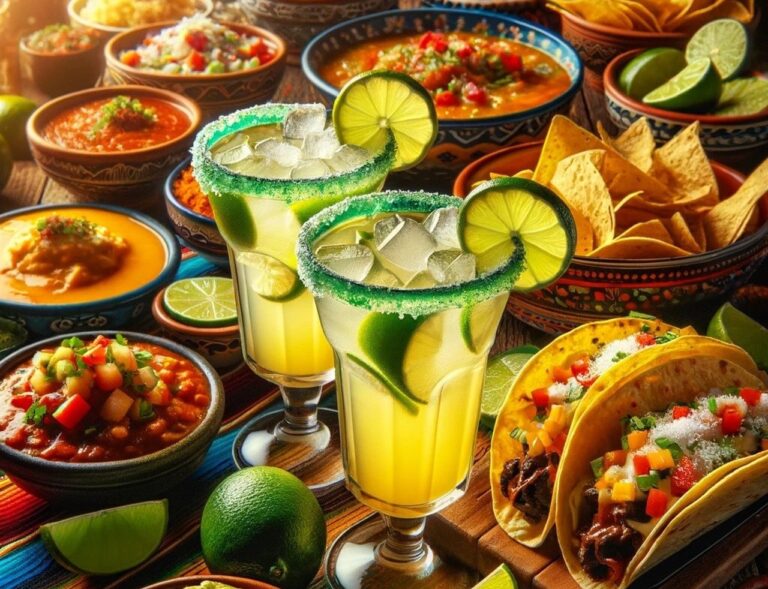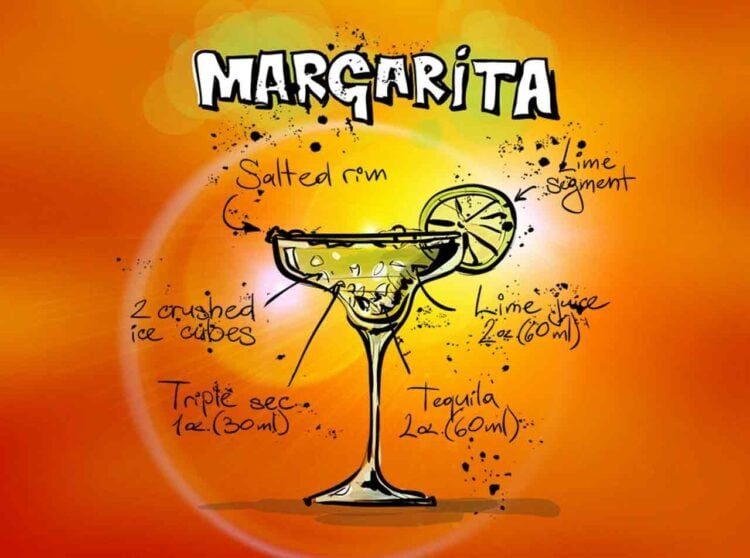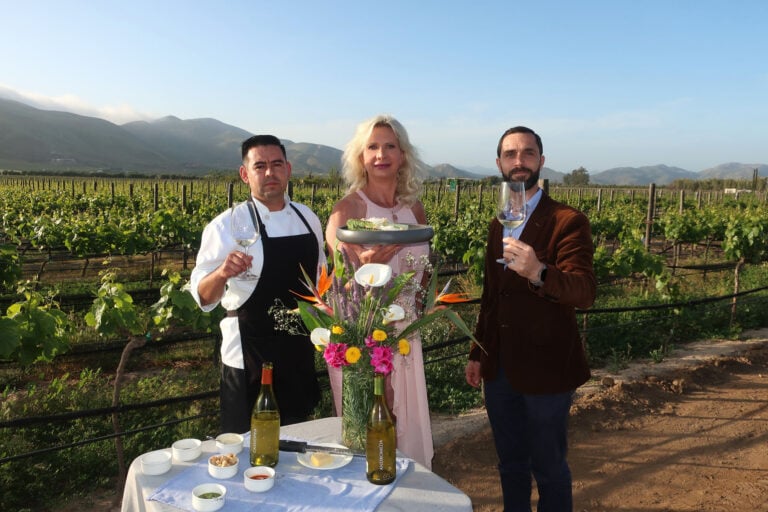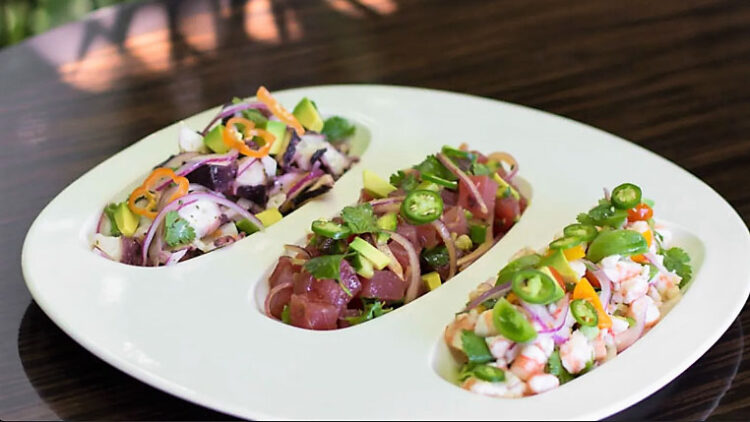Premier Grand Dinner in the Vineyards | Restaurant Lalique, Sauternais, France
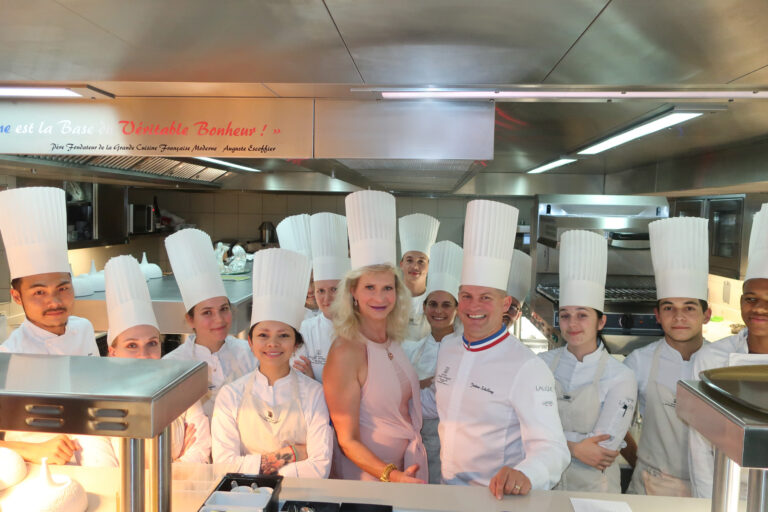
Fly away to Restaurant Lalique
Lieu-Dit-Peyraguey, Bommes, France, November 2023
Restaurant Lalique is part of GAYOT’s 2023 Restaurant Awards, Memorable Dinners of 2023
• GAYOT’s Rating: 18/20
• Cuisine: French
• Open: Lunch & Dinner Thurs.-Mon.
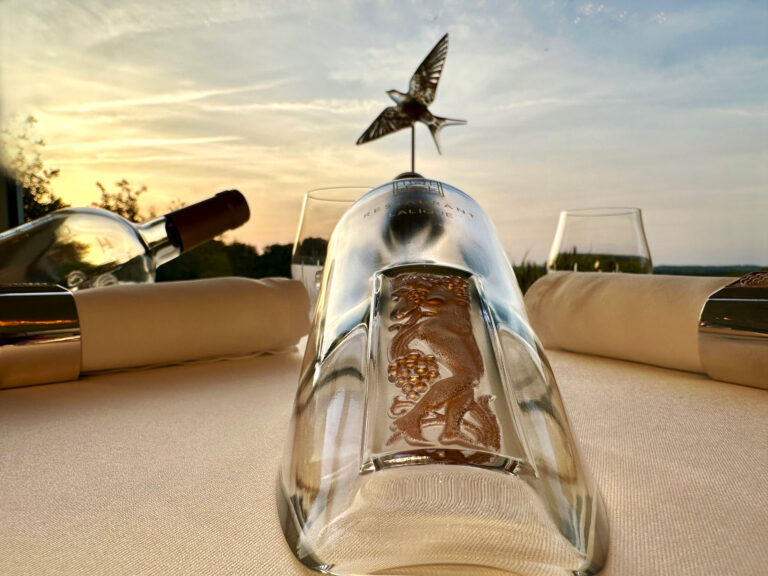
Château Lafaurie-Peyraguey
+33 (0)5 24 22 80 11 | View Website
GPS: Latitude 44.549573 | Longitude: -0.338376
The Heavy Weight of History
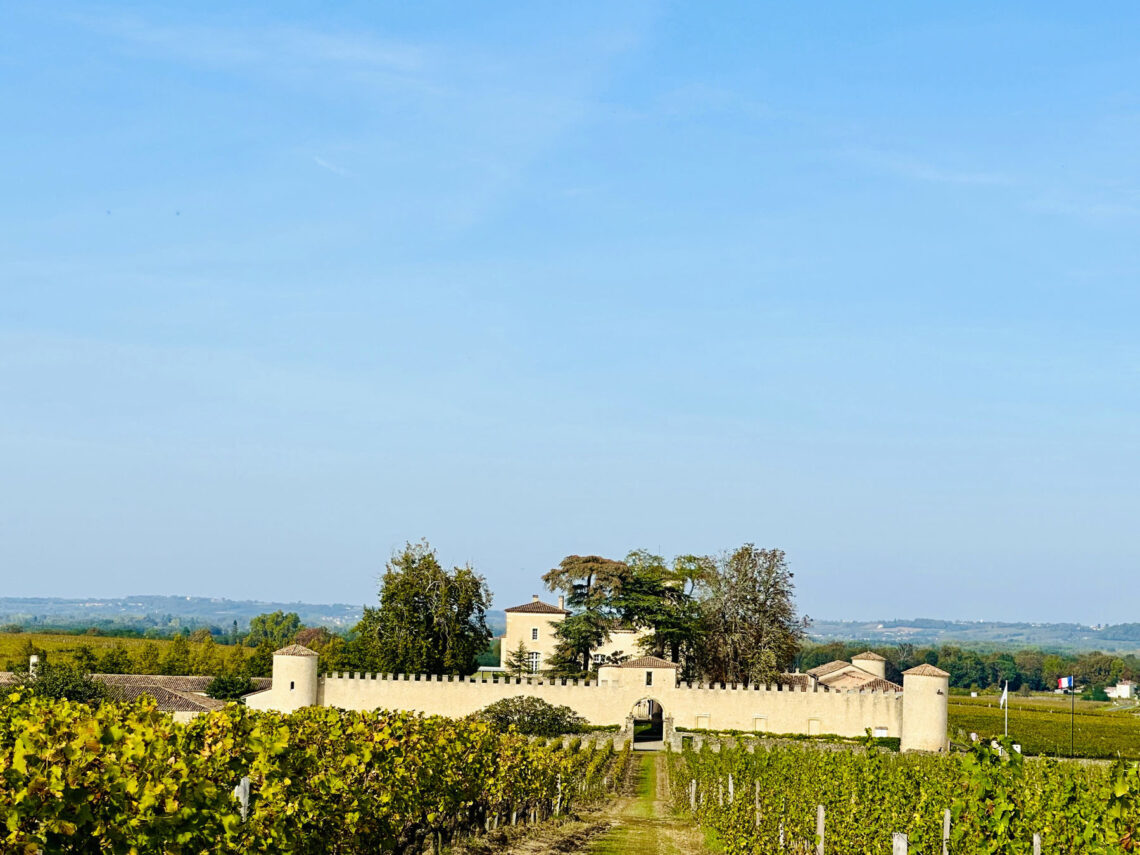
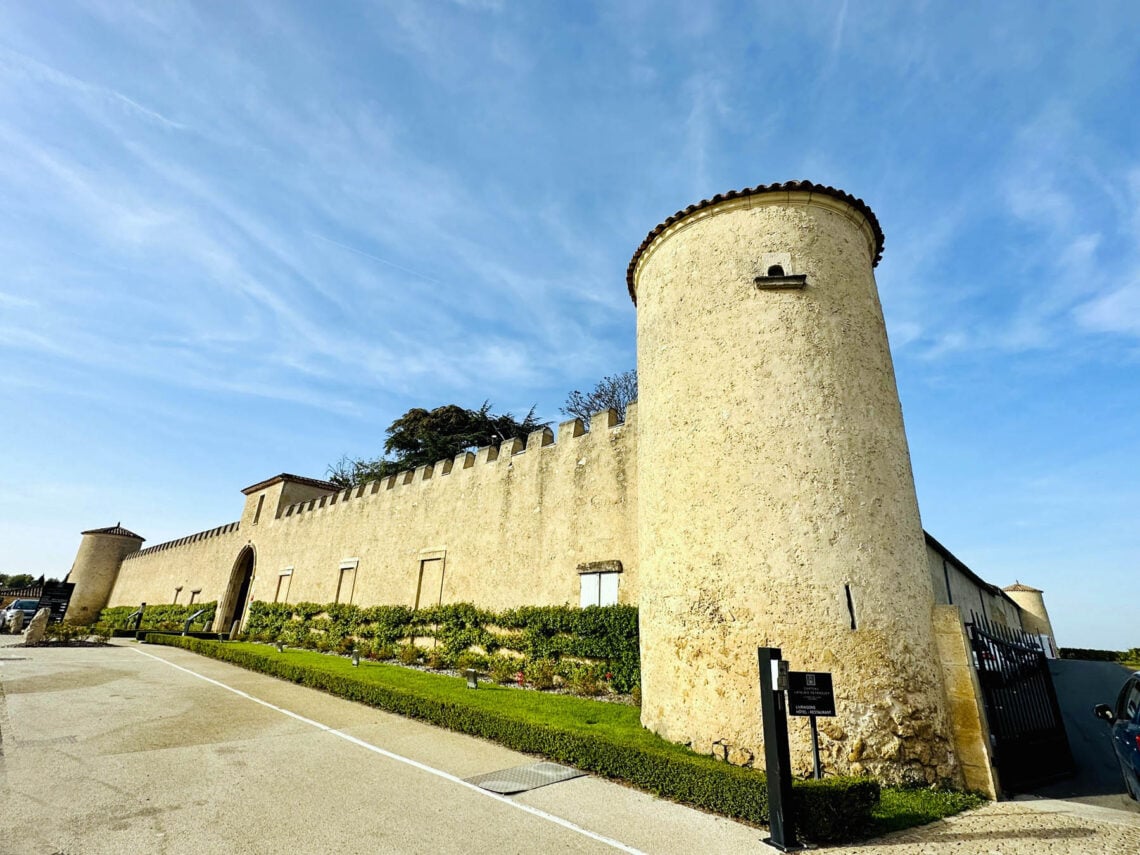
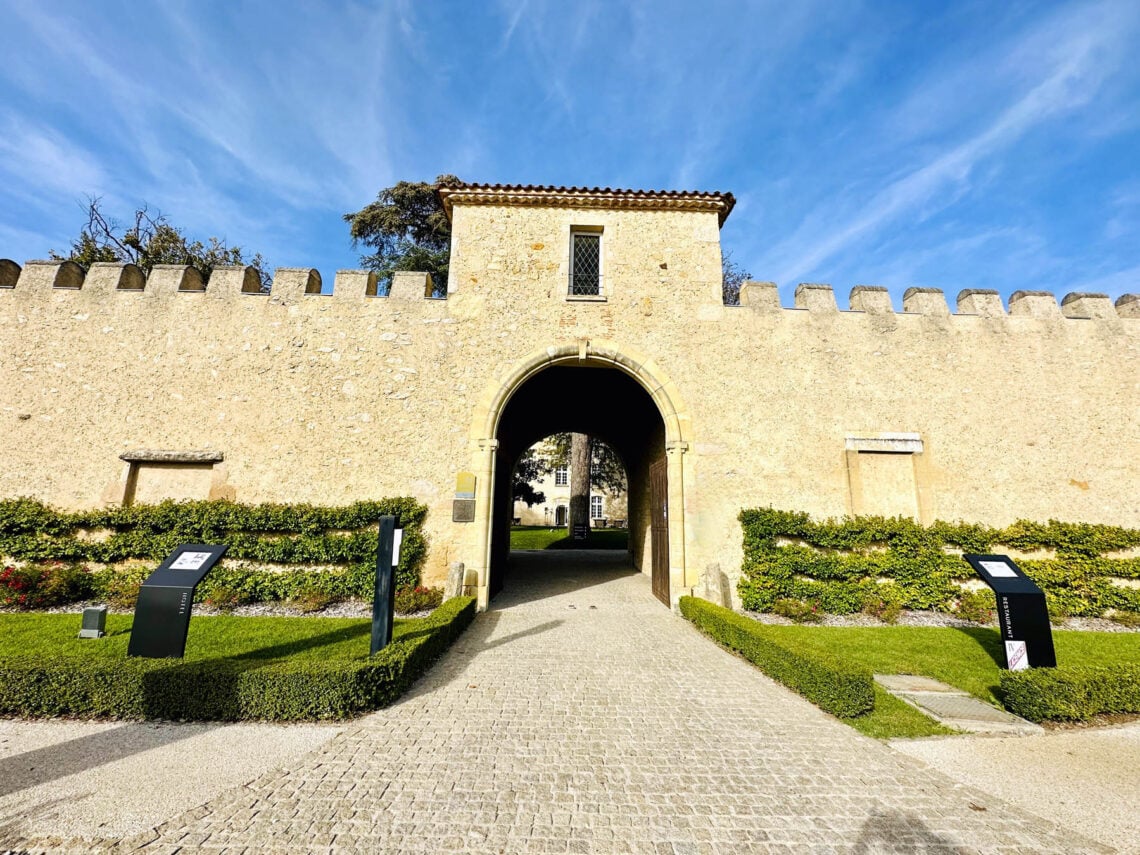
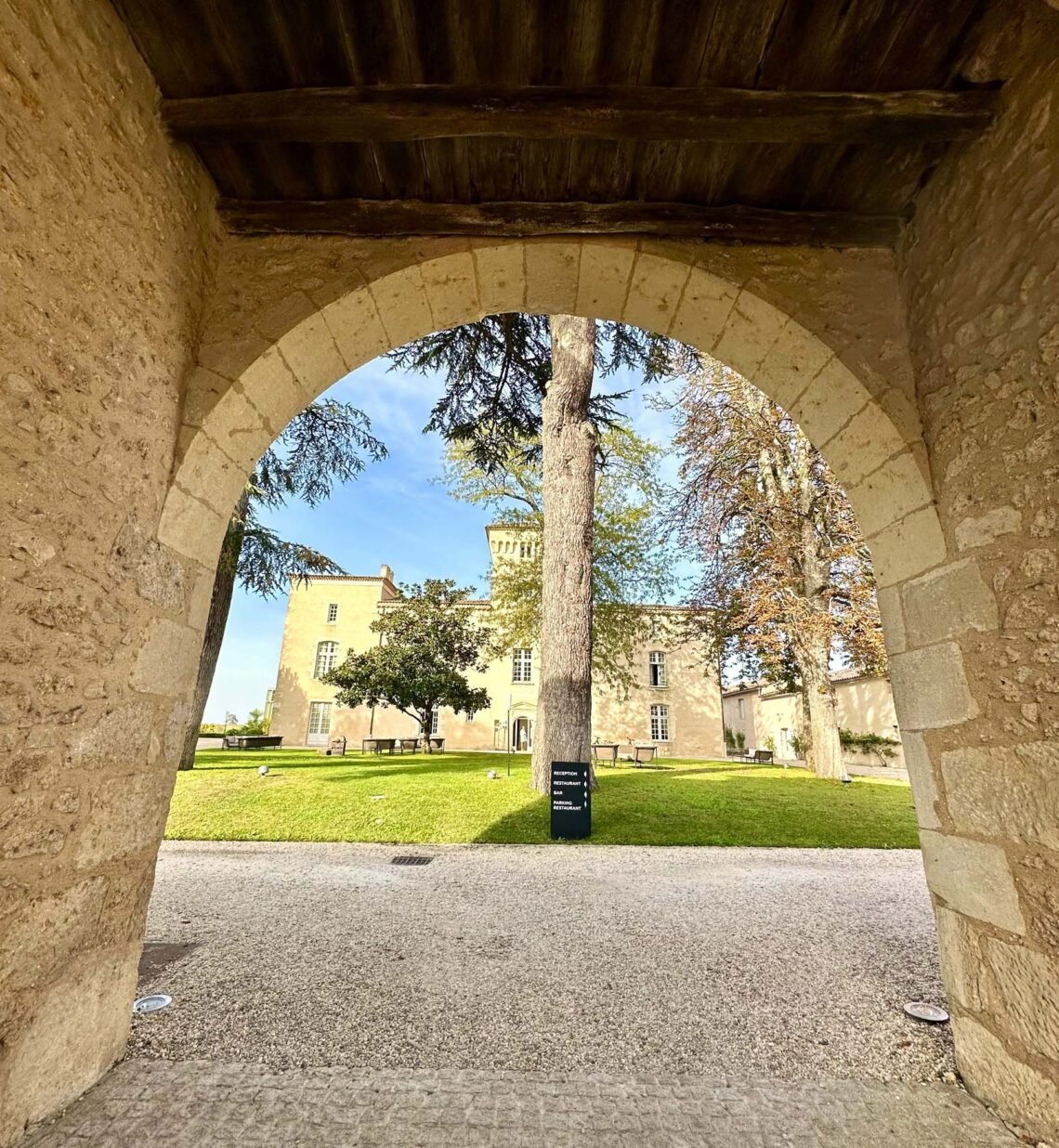
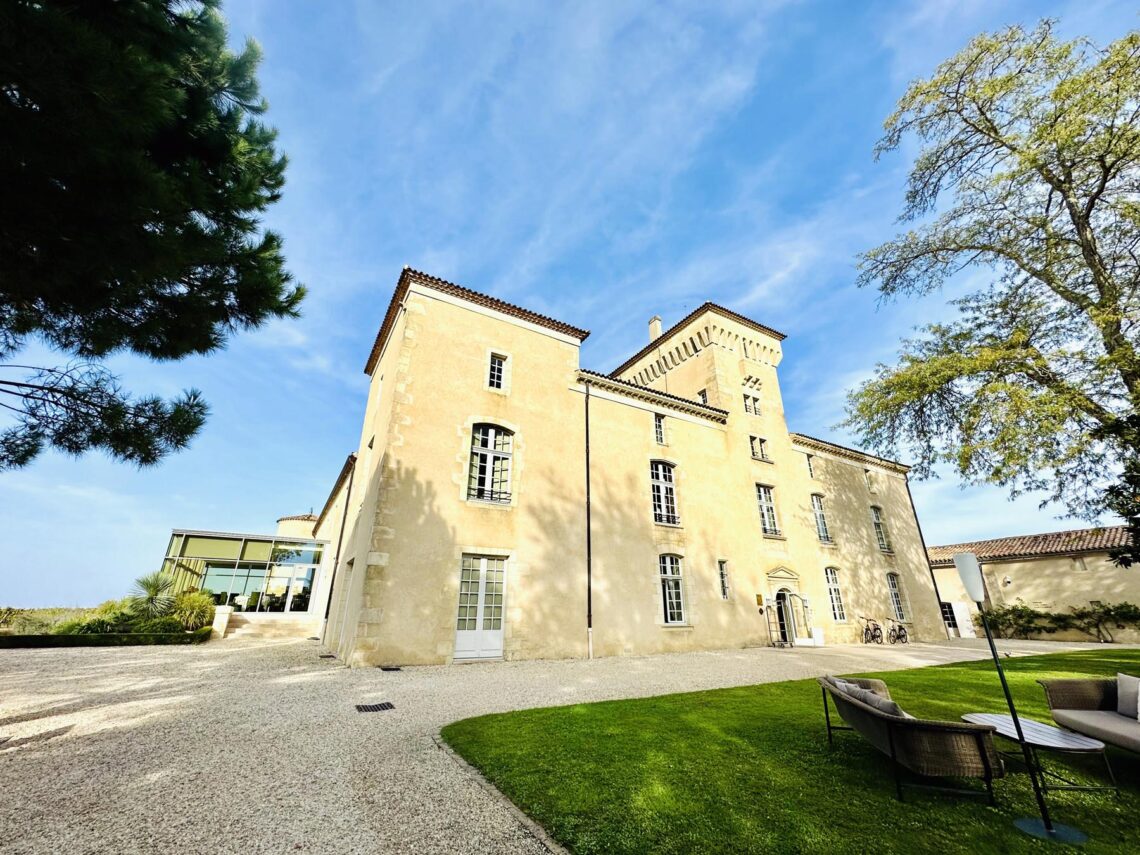
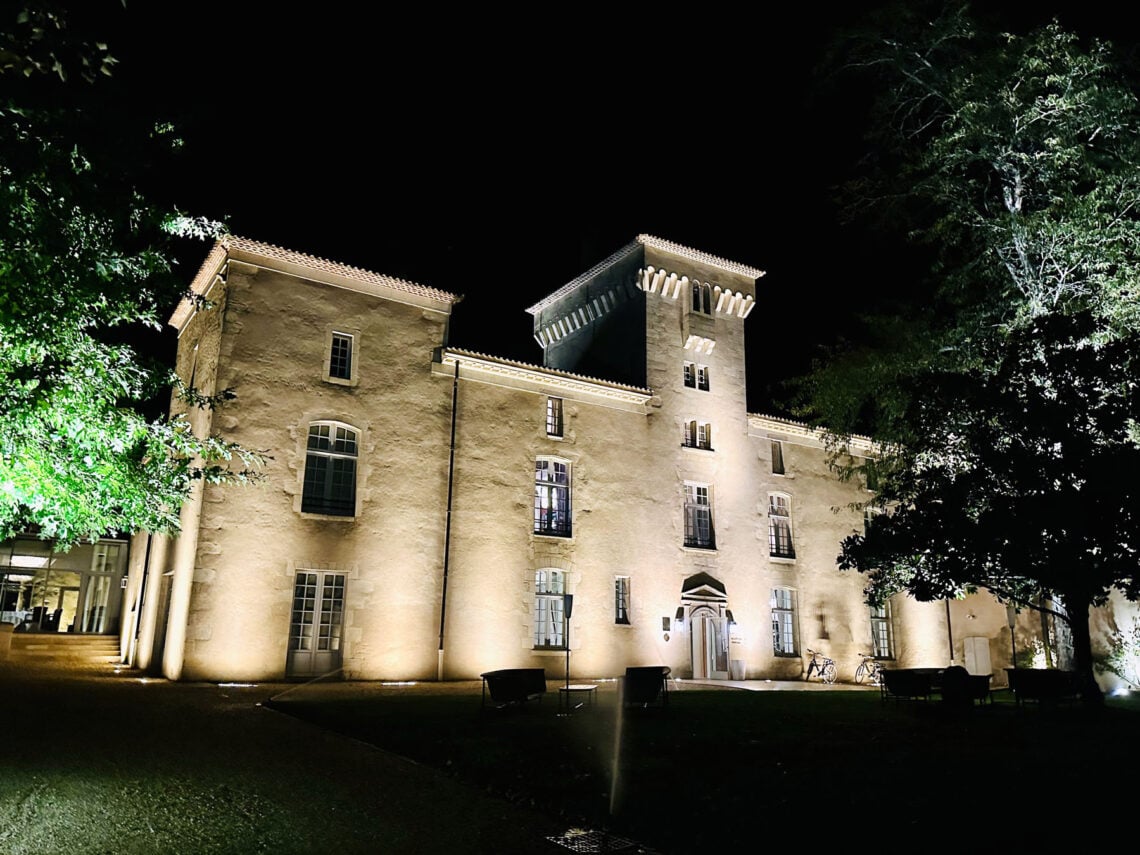
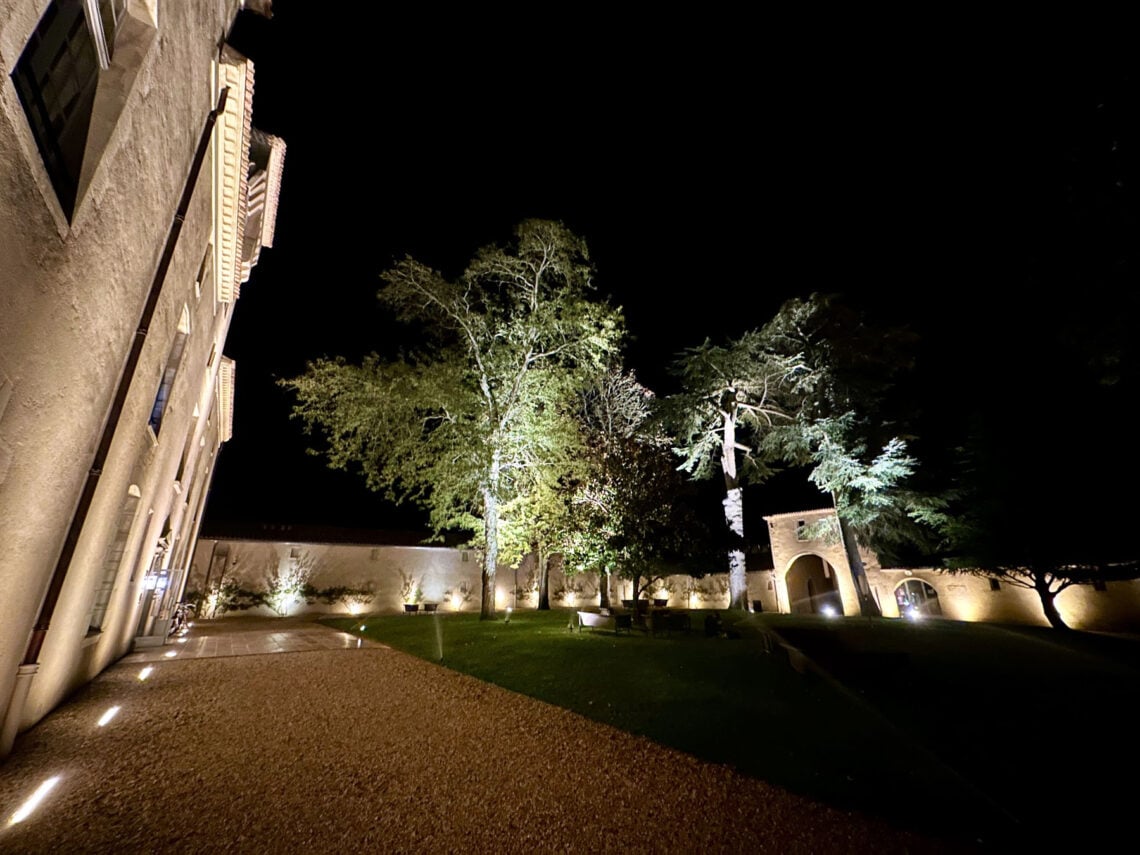
Château Lafaurie-Peyraguey, where Restaurant Lalique is nestled, has an intriguing history that can be traced to the Middle Ages in the thirteenth century. Some wood from the roof dates back to 1431. The first vines were planted in 1618 by the Peyraguey family. In 1682, Messire de Tuquoy, Seigneur de Montaut, a priest, bought the domain. He built his own chapel. In 1709, Messire Pierre de Pichard, an influential noble, took over — here were his titles: Seigneur Baron de Saucats; Barp-Toulousette, Poy, Patin, Miremont and Montaut; Seigneur Haut Justicier and Conseiller du Roi au Parlement de Bordeaux. After his passing, his son Baron Nicolas Pierre de Pichard, Conseiller du Roi and president of the Bordeaux Parlement, ruled. He also owned Château Lafite from 1786 to 1794. He reduced the size of the vineyard to privilege the quality over quantity. In 1787, while in Bordeaux, Thomas Jefferson bought a few bottles, and later ordered 85 cases of 12 bottles. The Baron Nicolas Pierre de Pichard was guillotined in 1794, Place de la Concorde in Paris (ah, these French…).
In 1796, Pierre Lafaurie purchased the property at an auction. That is when the Château got its present name. His son, also named Pierre, took the reins in 1836. Thanks to his efforts, Château Lafaurie-Peyraguey was listed as number 3 in the still current “Classification officielle des vins de Bordeaux de 1855” (see below). King Alfonso XII of Spain became a famous customer. In 1865, the owner of Château Lagrange, Comte Duchâtel, former Ministre de l’Intérieur and Ministre des Finances, modernized the technical installations and renovated the Château in a Spanish-Byzantine style.
In 1917, Désiré Cordier added Château Lafaurie-Peyraguey to his other properties Château Talbot, Château Gruaud-Larose and Château Meyney. Then a French conglomerate was in charge until 2014, when Swiss businessman Silvio Denz, the owner of Lalique, one of the world’s most renowned makers of artistic glass objects, put his hands on the eighteen hectares of premier land of the most famous vin liquoreux territory that is Sauternes. Let me not forget to mention that Denz’s portfolio includes Château Faugères and Château Péby-Faugères, both Grands Crus Classés Saint-Émilion, and Domain Montepeloso in Tuscany.
The Lalique Era
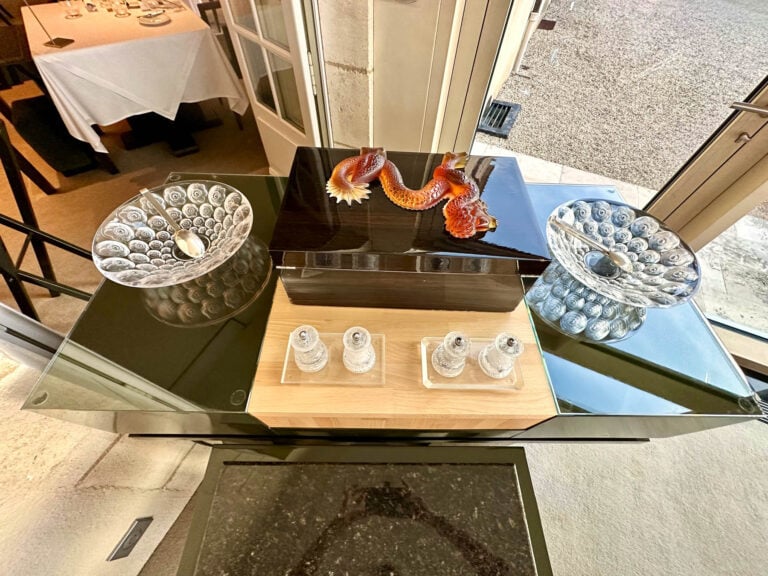
Silvio Denz is a visionary and has infused his sense of entrepreneurship at Château Lafaurie-Peyraguey. To celebrate the 400 years of the domain, in 2018, a brand new hotel and a restaurant became part of the landscape. As being the owner of Lalique, he named them Hôtel & Restaurant Lalique.
But bearing the name left by René Lalique comes with a legacy, a legacy of art de vivre, elegance and luxury. In his time, starting in 1888, René Lalique was a jewelry designer, quite avant-gardiste, mixing semi-precious stones with glass, enamel, nacre and leather. The famous French verrier, Émile Gallé, bestowed upon him the title of “Inventor of the modern jewel.” During the 1900 Universal Exposition, Lalique was considered as an Art Nouveau master. More projects (among them perfume bottles), more distinctions led him to design the interior of the first-class dining room of the Normandy cruise ship (1936) in the Art Déco style, and the fountains that are the beginning of the most beautiful avenue in the world, Les Champs-Élysées, at the Rond-Point. After his death in 1945, his son, Marc, embarked the company to a somewhat different path with crystal creations. Crystal from Lalique is not your usual crystal. It has texture and can be polished, or depolished, and brilliant or frosted. It has its very own distinctive signature and identity.
Since the arrival of Denz, an art and wine collector, Maison Lalique has been perpetuating the Art Déco style created by both René and Marc, but has elevated itself to a more luxurious market segment, and collaborates with prestigious brands such as Bentley, Cognac Hardy, The Macallan and Steinway.
This is the backdrop and context into which chef Jérôme Schilling comes in. Yes, Schilling has a brand new restaurant and kitchen, but it cannot be an easy endeavor to compose and deliver a menu in a lieu with so much history, heritage and significance, all three famous and celebrated beyond the frontier of France.
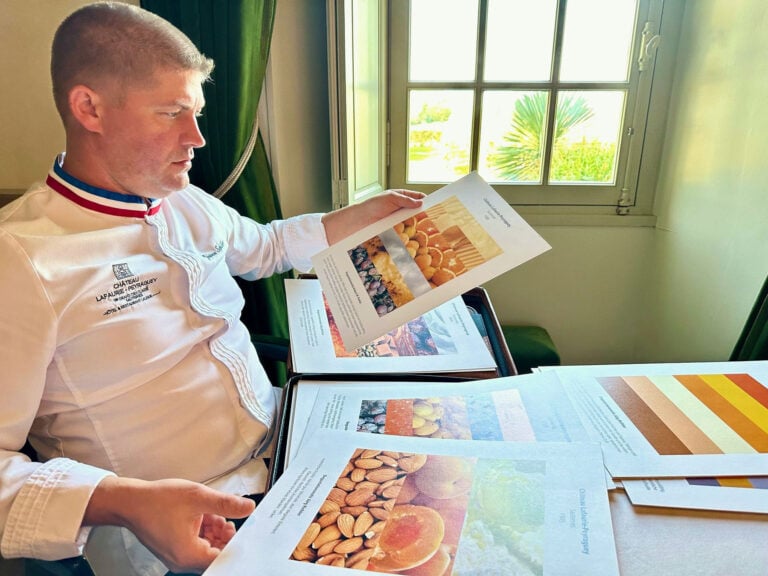
The Décor
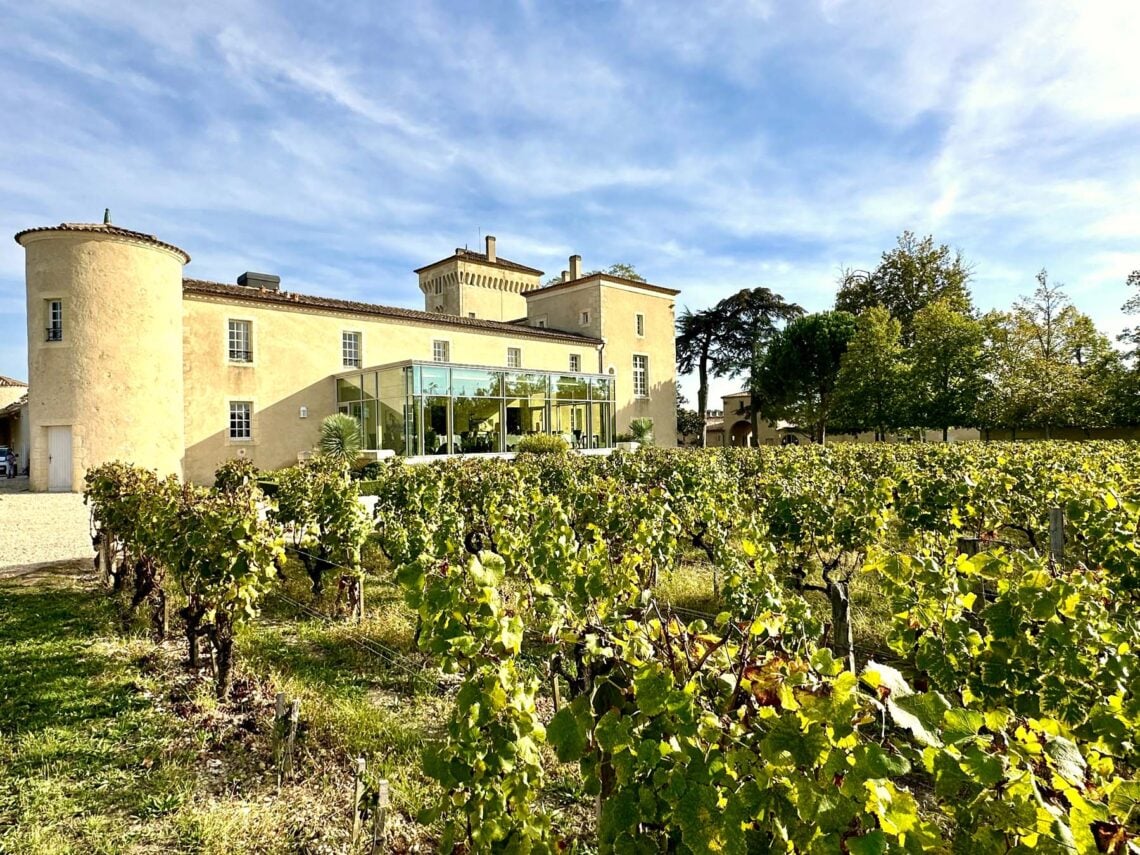
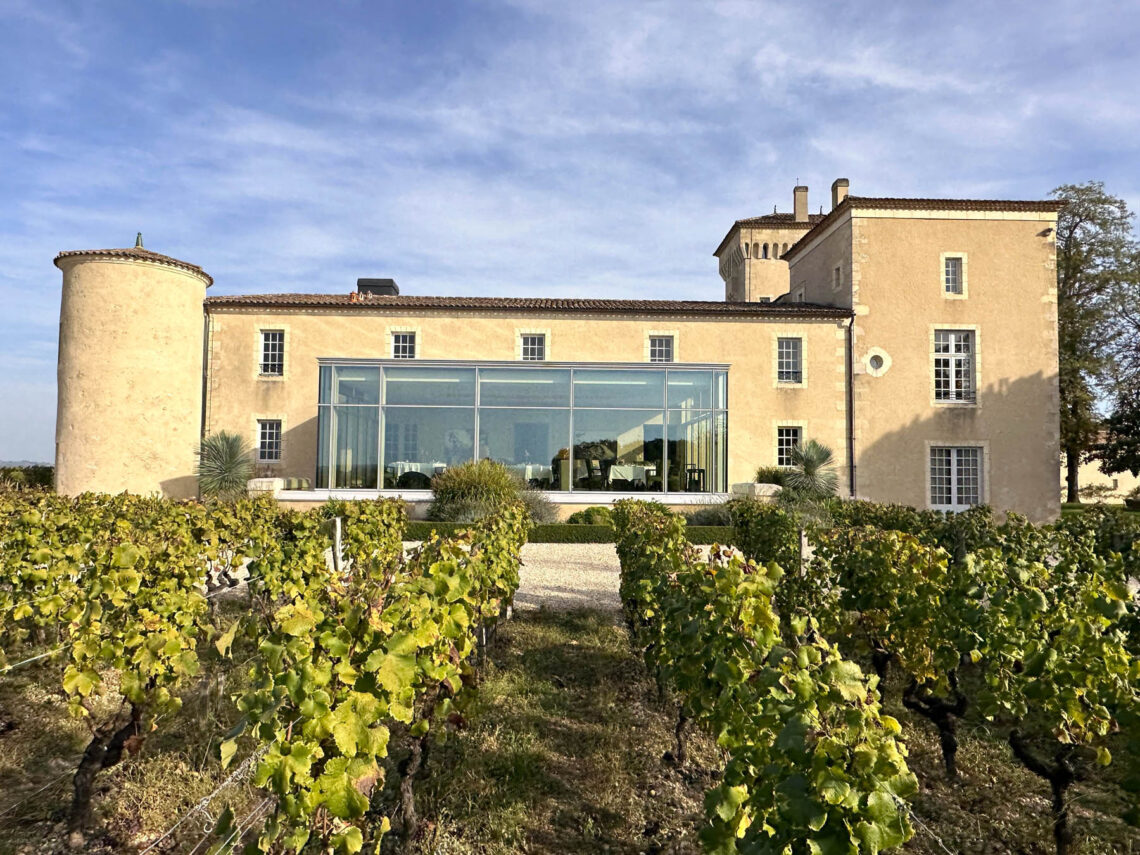
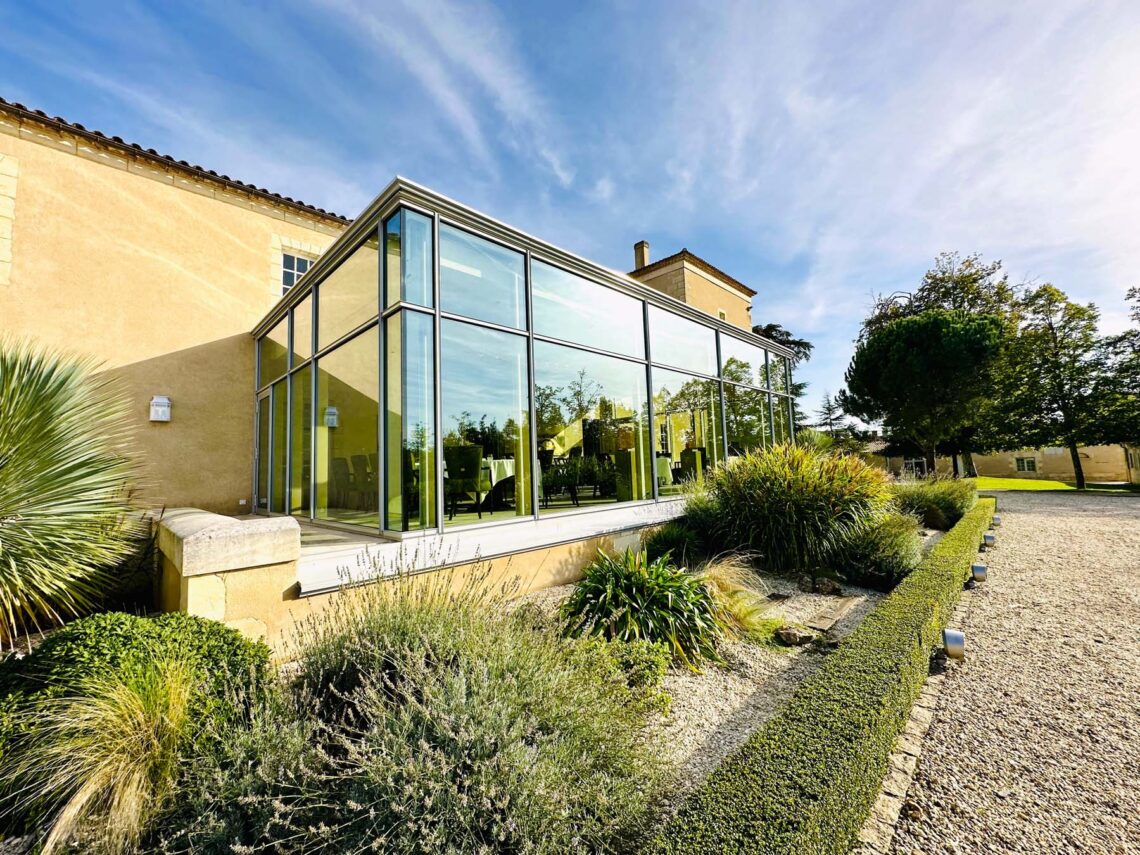
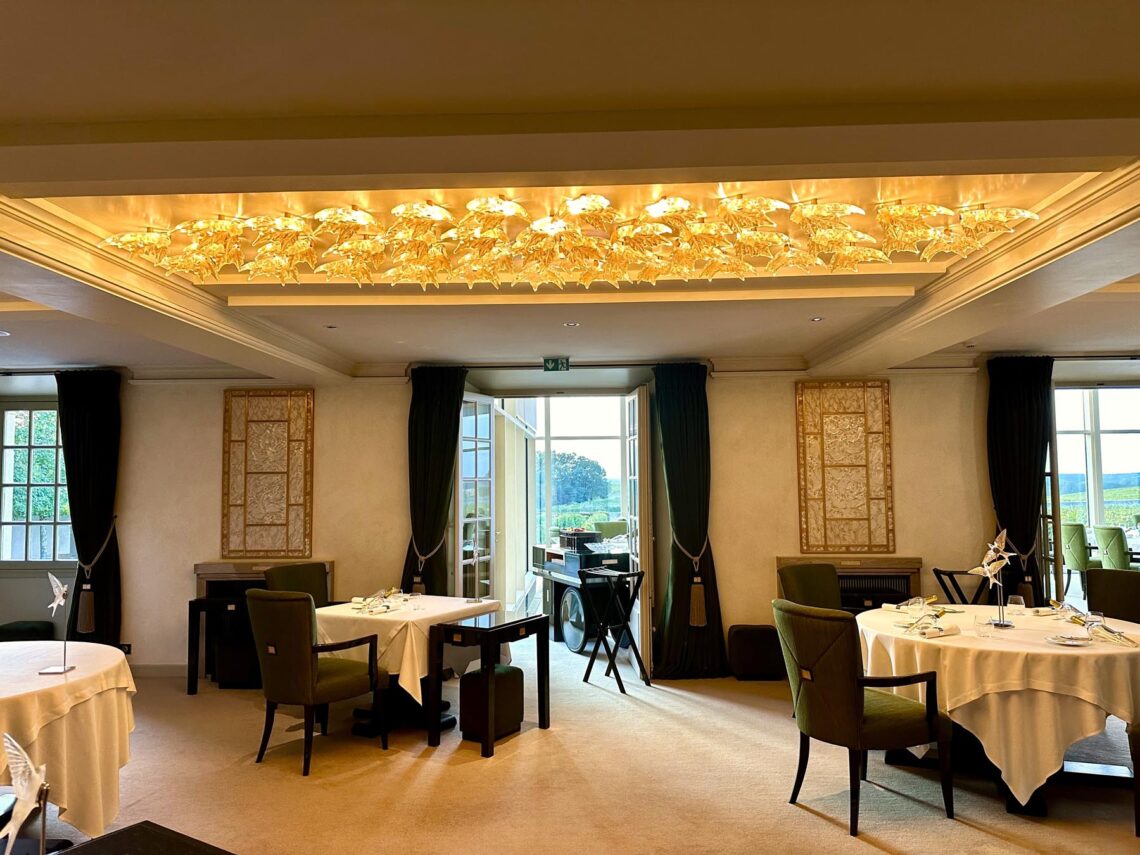
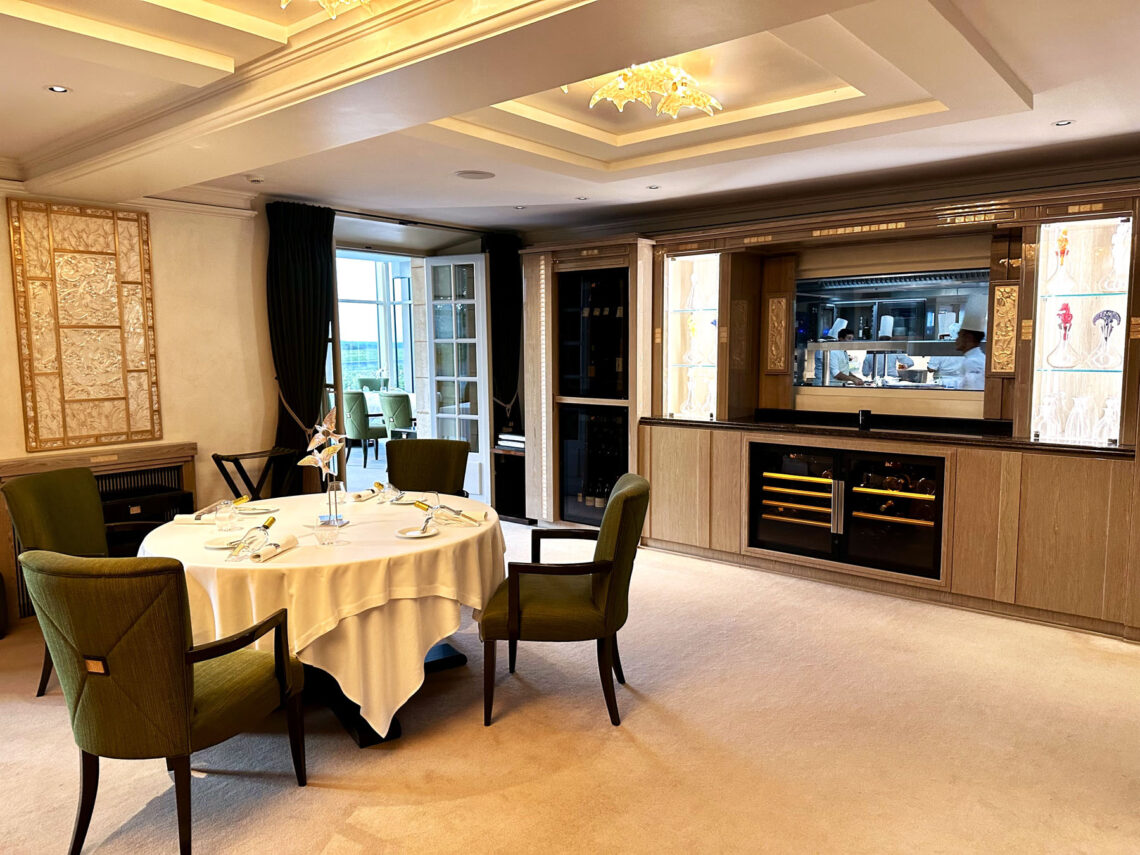
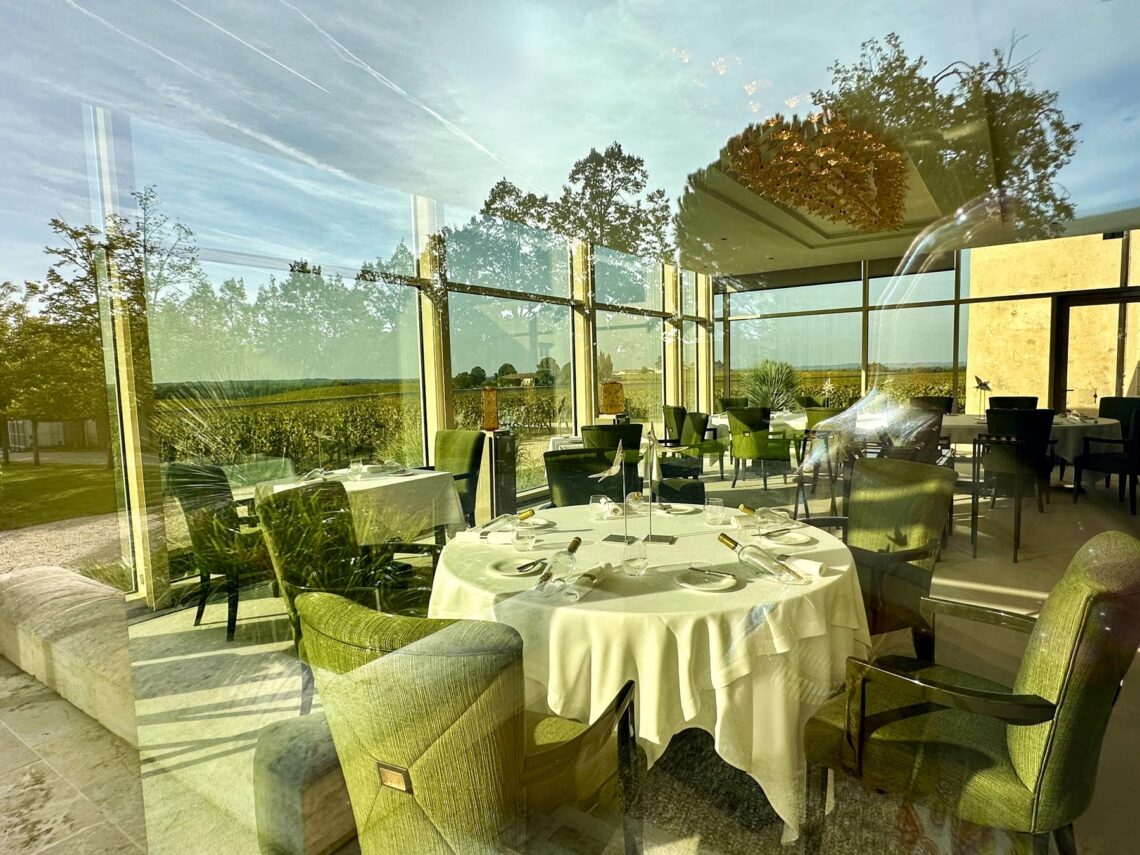
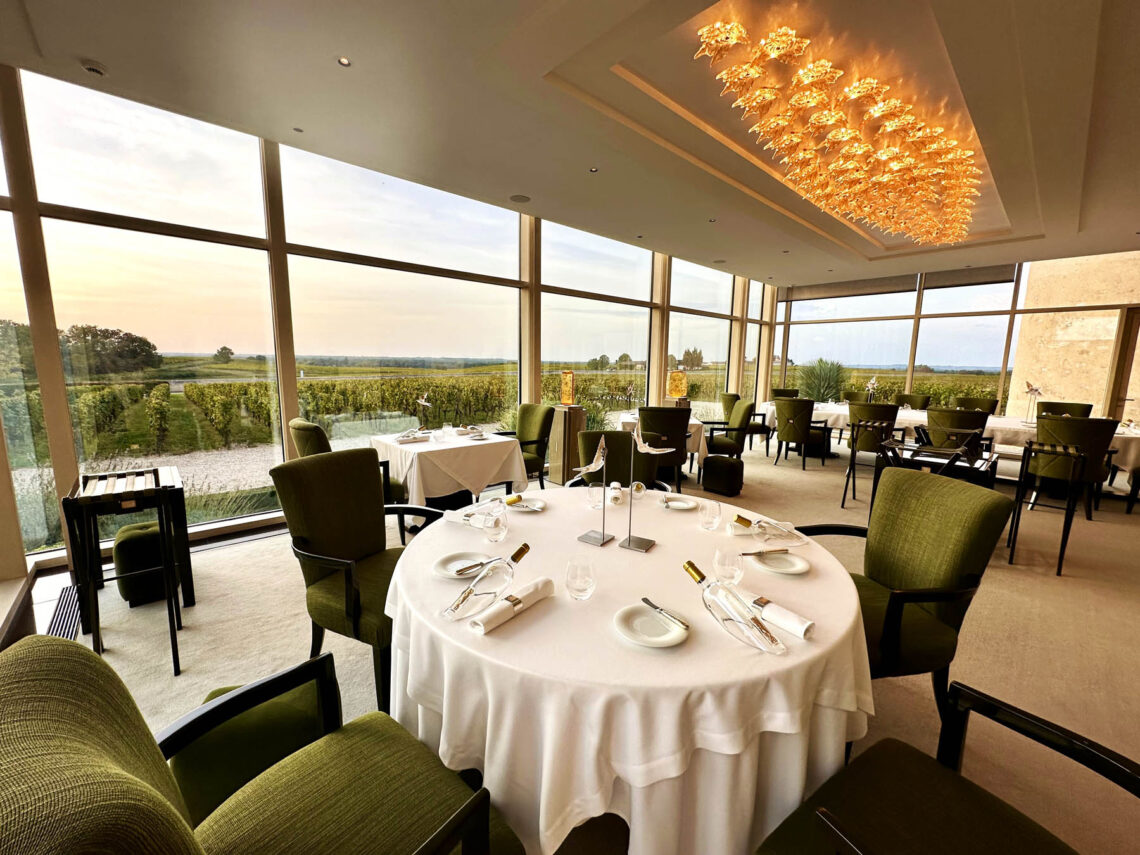
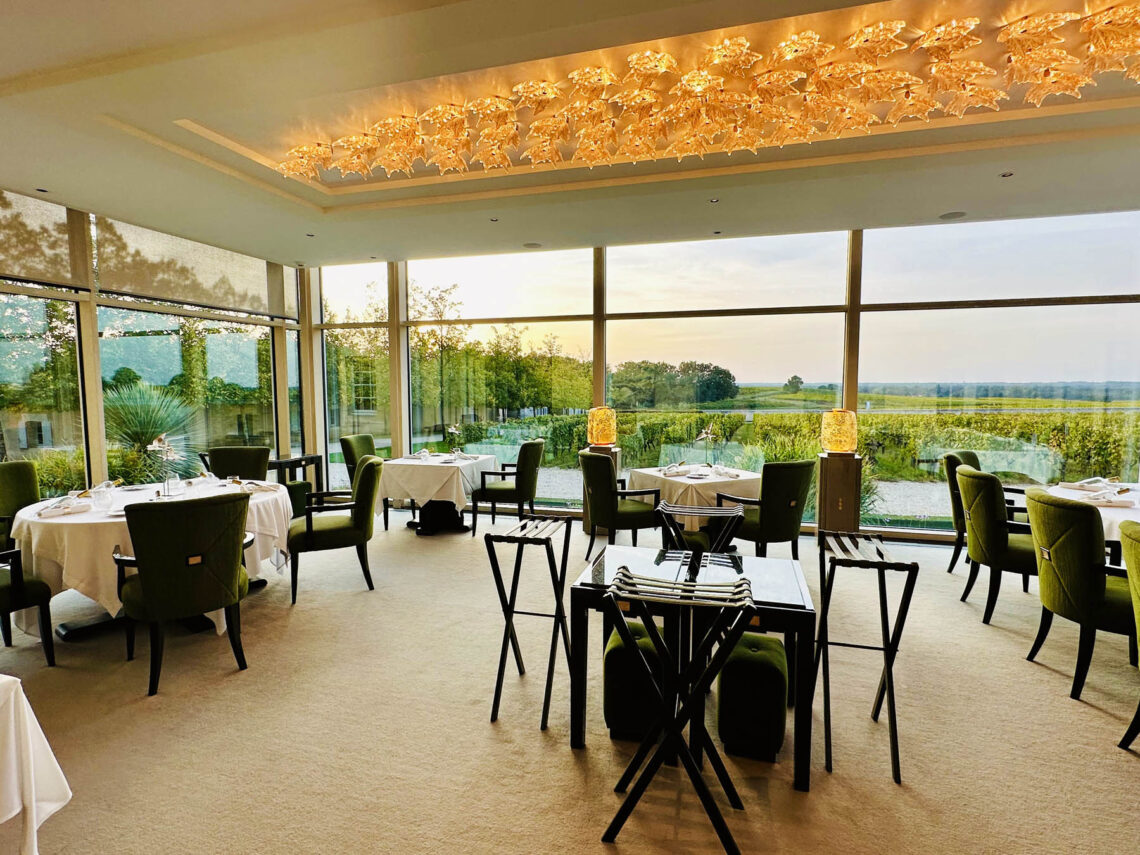
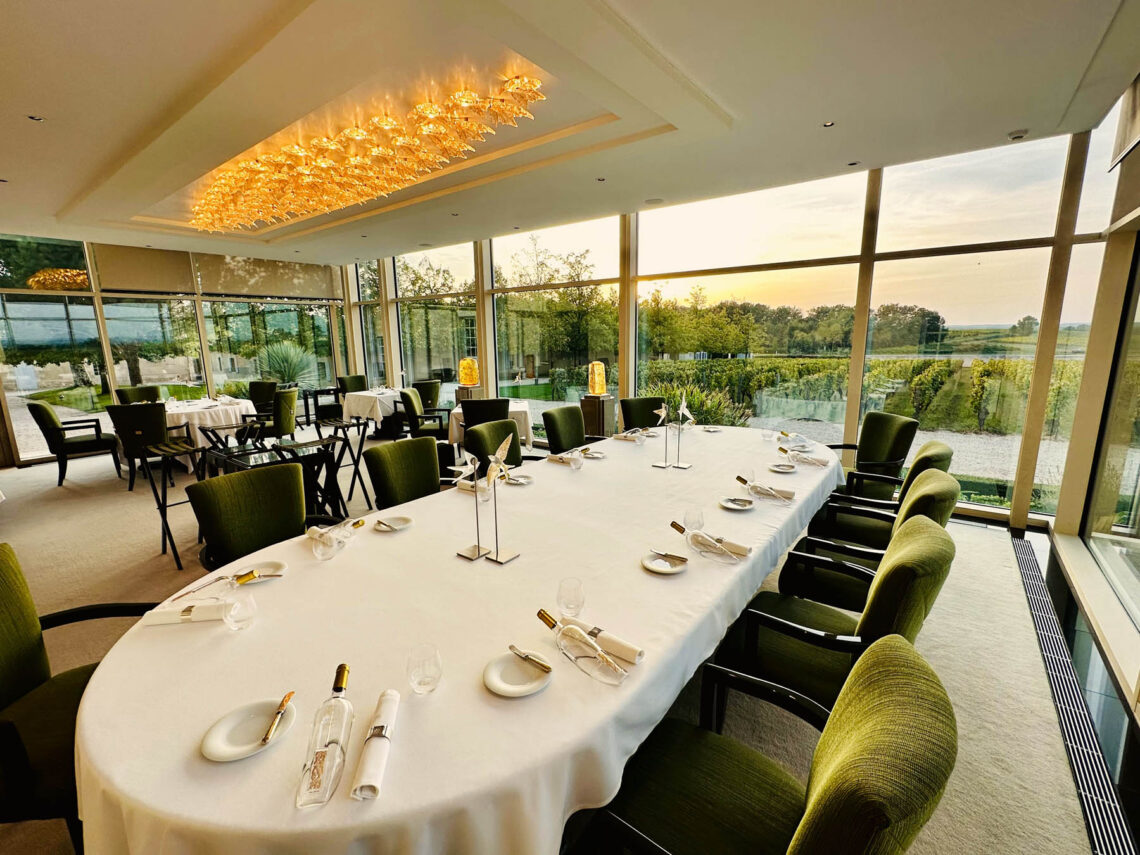
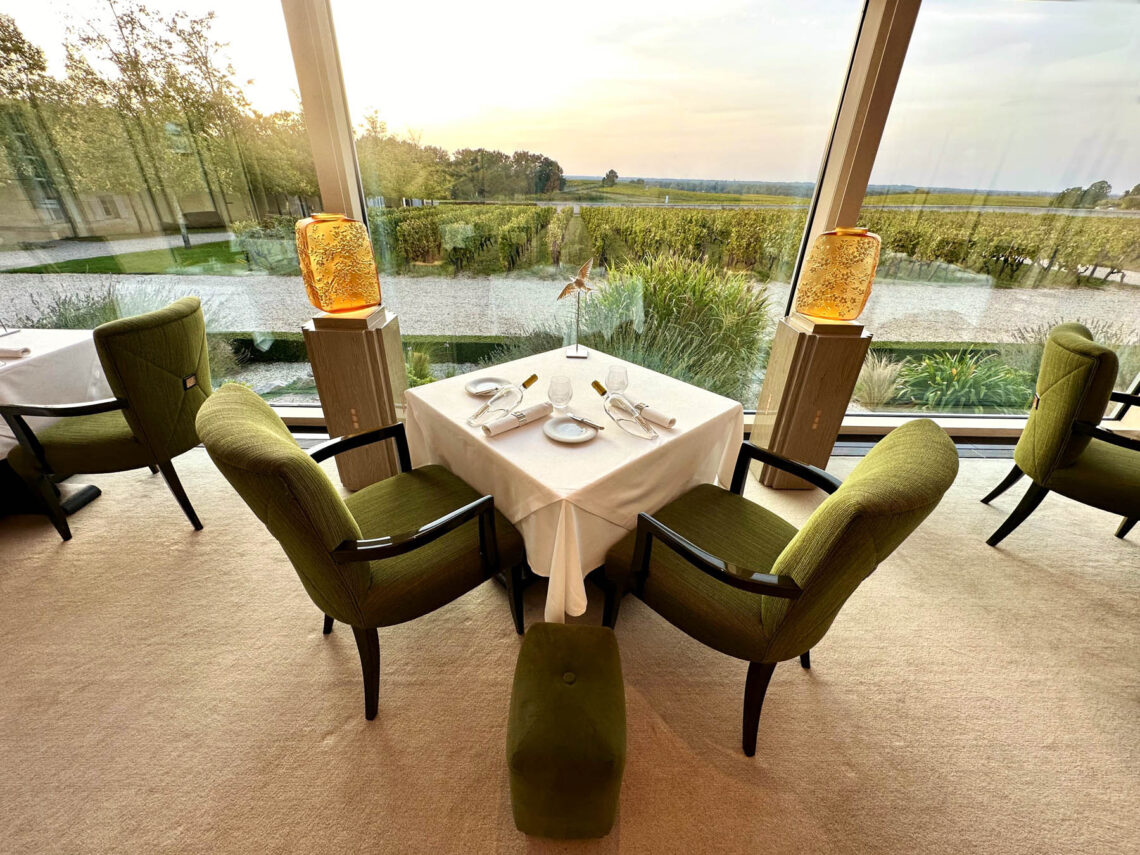
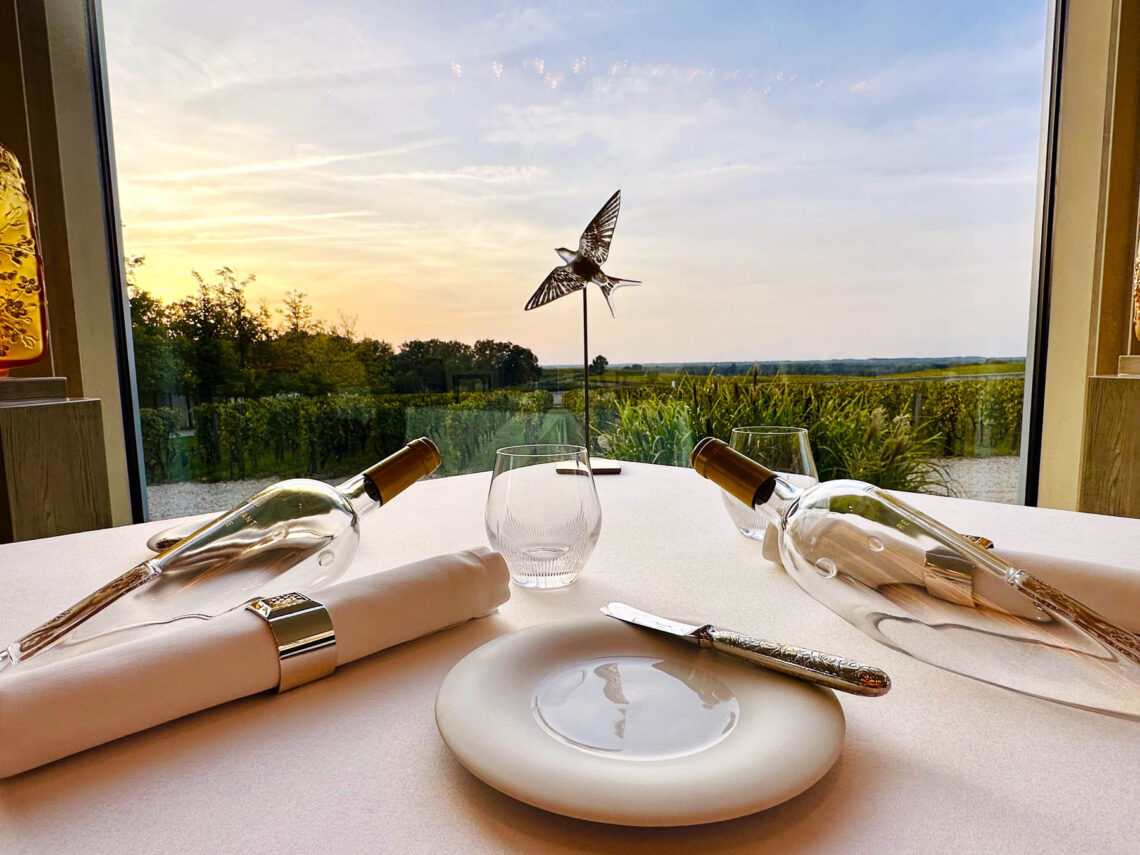
Restaurant Lalique is located in the main building, a structure from the seventeenth century. To give it more covers, none the less than architect Mario Botta was commissioned. Considered the “master of light and gravity,” he is the father, among other massive projects, of the San Francisco Museum of Modern Art and the Cymbalista Synagogue at Tel-Aviv University. He conceptualized a metallic structure adorned to the west façade. Floor-to-ceiling glass let you admire the sunset and the vineyards. If you are sitting in the room inside, you will be in symbiosis with the kitchen through a large window, flanked by Lalique flacons.
The inside Art Déco design of both rooms was delegated to the decorators of Maison Lalique, Lady Tina Green and Pietro Mingarelli. Every single one of the decorative elements, and the tableware (except the plates and silverware), are from Lalique, or has a Lalique touch, like crystal inlay on the back of the chairs. I really like the “bottles” laid on the table, engraved with a drawing by René Lalique of Lady & Grapes. Since 2013, this gravure is on every actual wine bottle (a bottle to keep once the Sauternes is gone).
You need to pay attention to the ceilings of both rooms and admire the golden Lalique leaves. Do not get fooled like I did. The leaves are not vine leaves (you would think so considering where you are), but they are platane leaves. They come from the Lalique “Champs-Élysées” collection, a line named in homage to René Lalique’s work on the Champs-Élysées, where the trees on both sides of the 1.9-kilometer avenue (1.2 mile) are platanes.
The Chef at Work
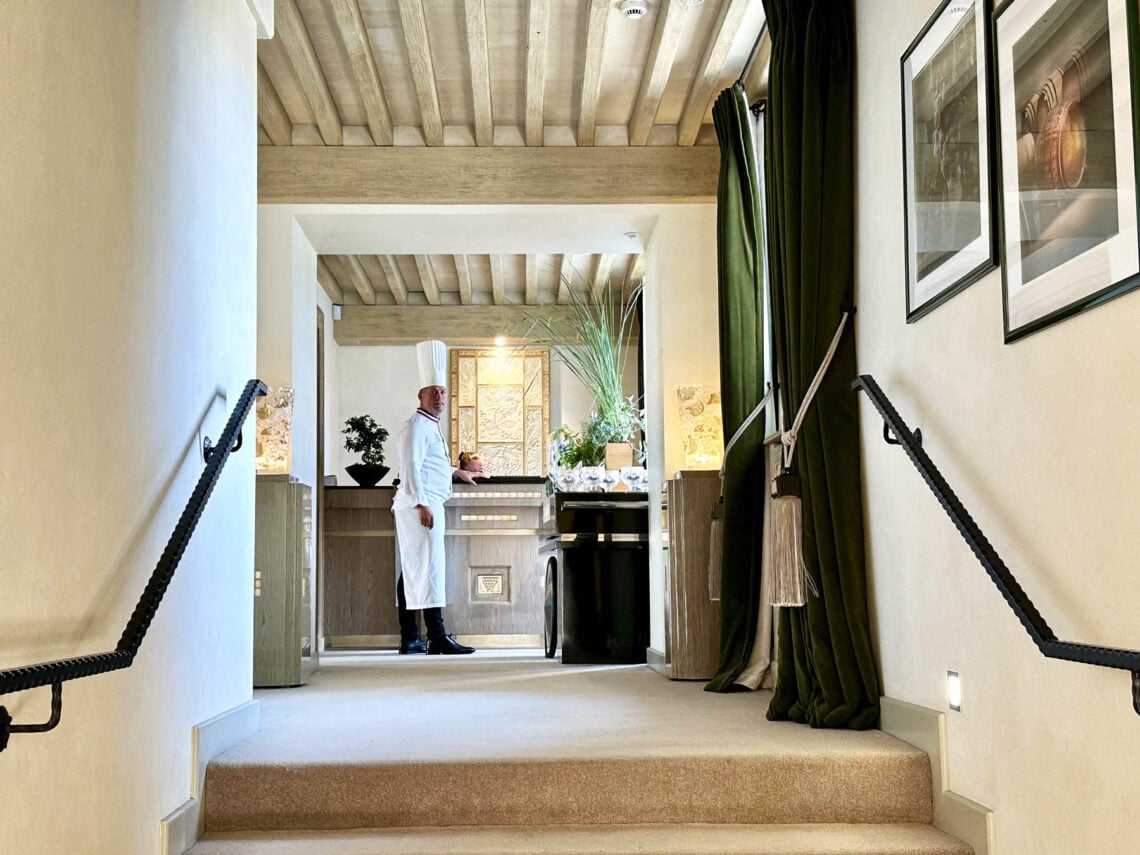
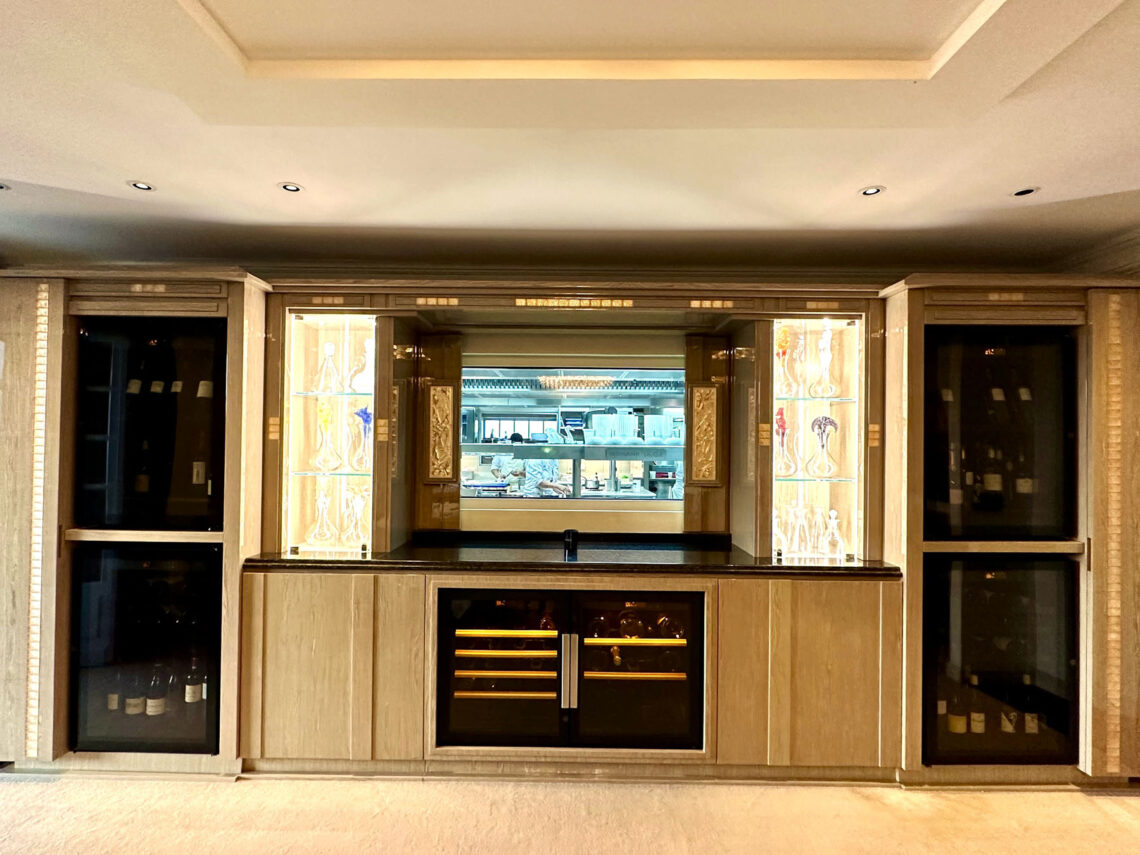
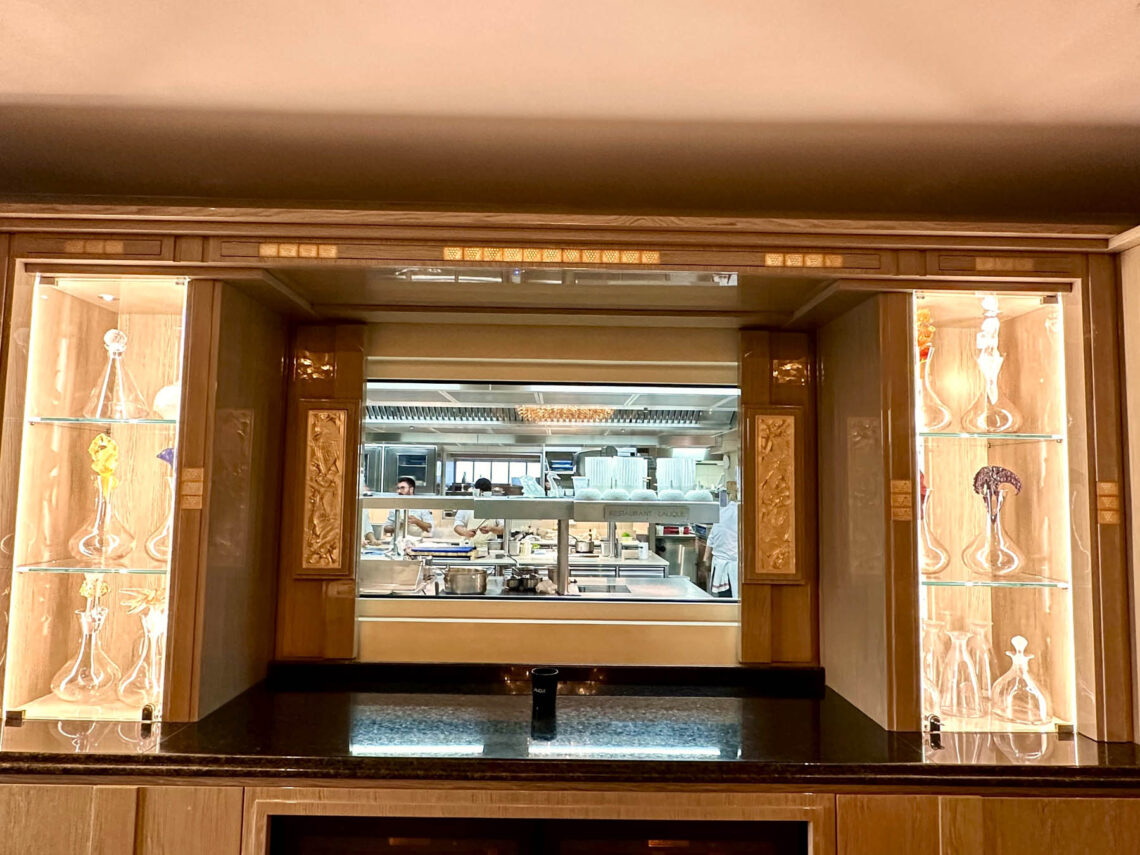
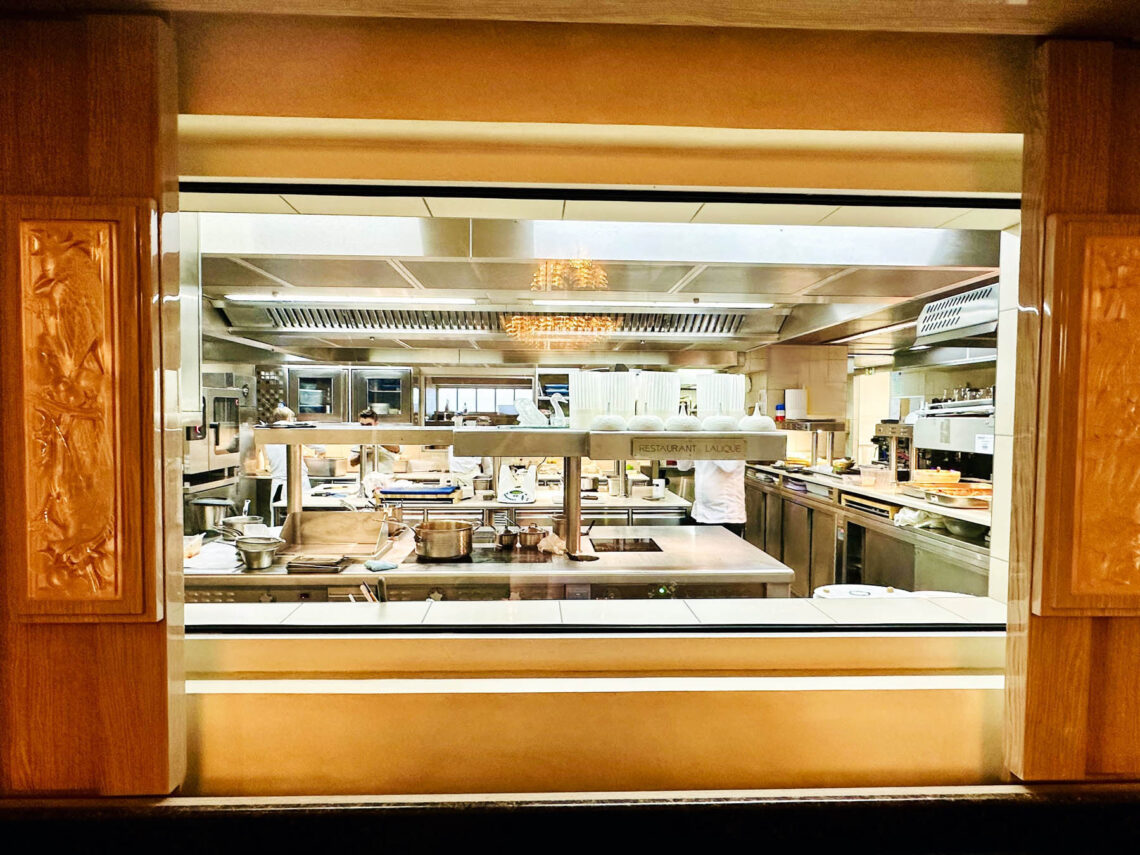
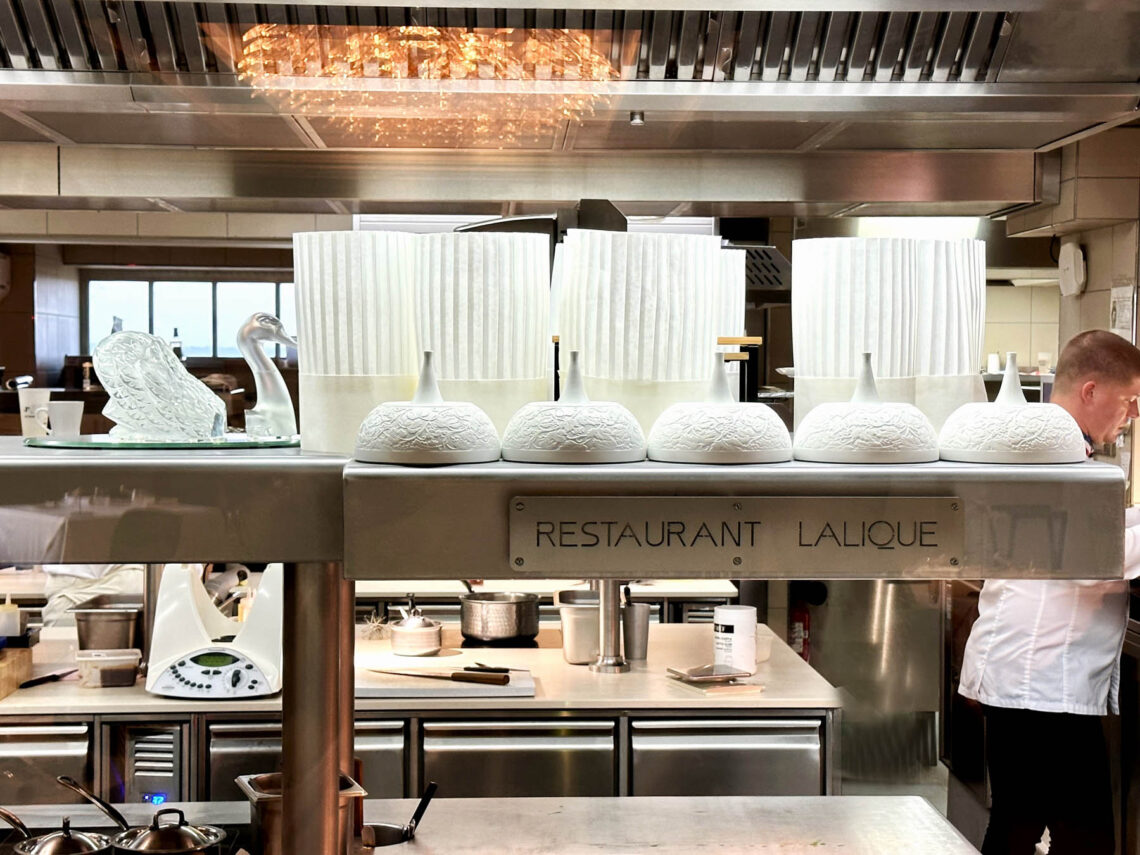
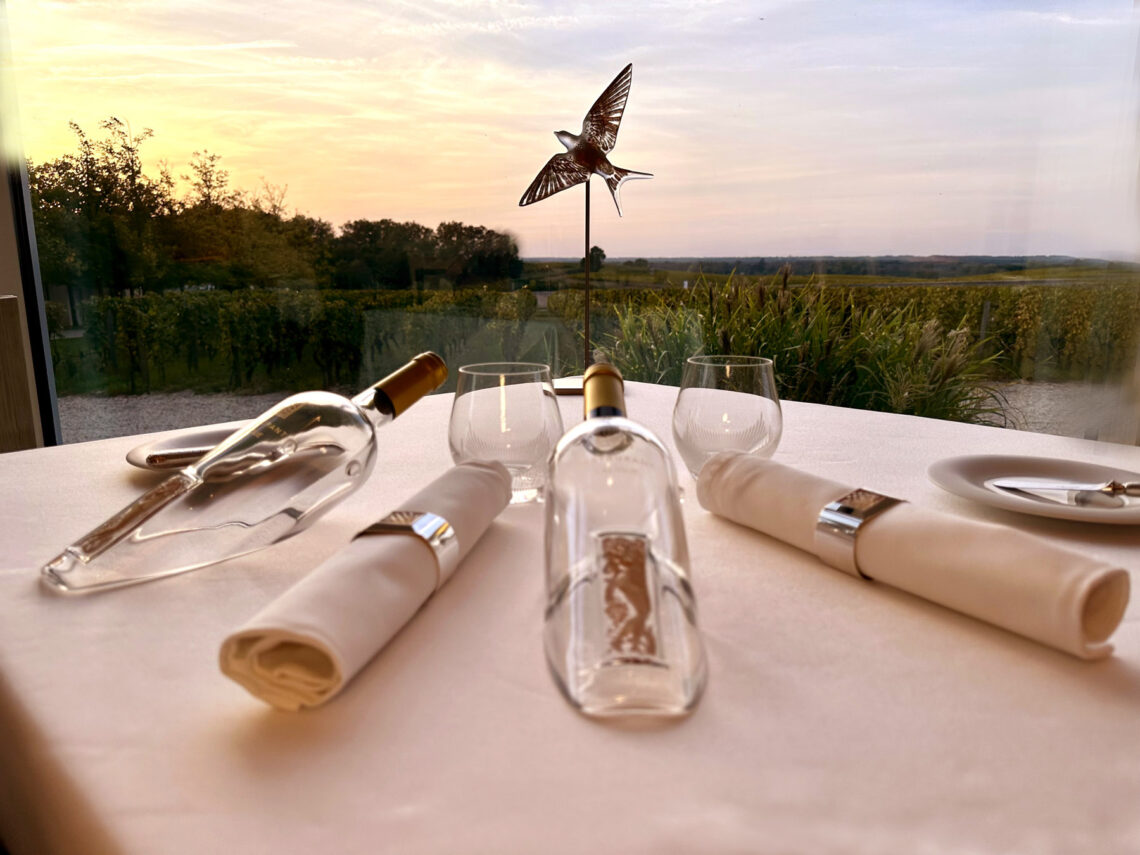
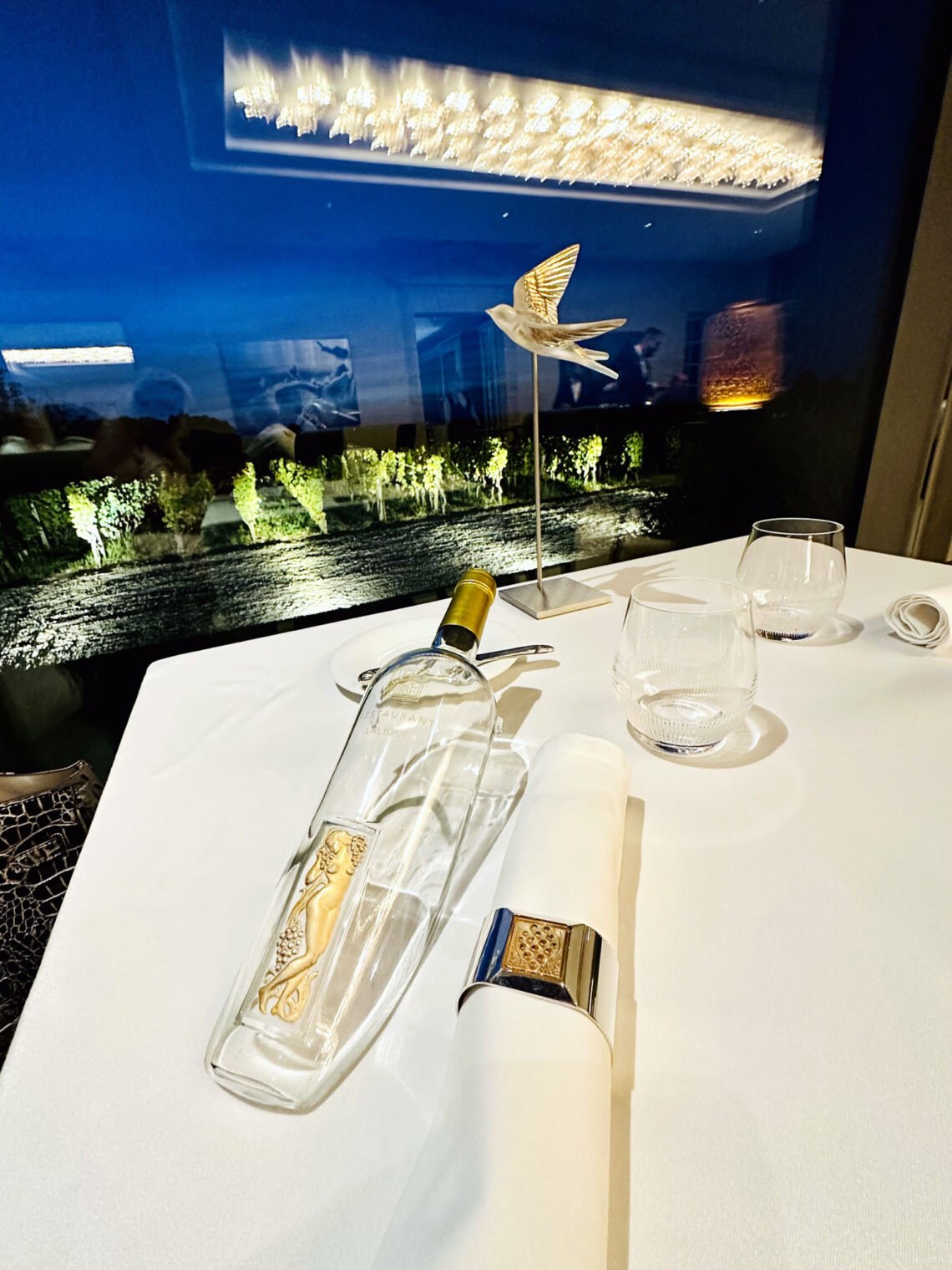
The cuisine of Chef Jérôme Schilling is as precise and artful as Lalique’s glass work. It is vibrant, stylish, sophisticated, and carries the imprint of haute-gastronomy famous to France — which we know is the best in the world. His repertoire is based on classic techniques, learned from his peers (and none the less than from the chef we named “Cuisinier du Siècle” that is Joël Robuchon), and modernized next to chef Thierry Marx.
He leads a team of sous chefs, all wearing chef’s hats, and very concentrated on their work, eager to perform for the happy few who made the trip to the heart of the très exclusive Sauternes region — peak through the aperture allowing you to contemplate the ballet of the white toques. Schilling is a man of passion. He is poised and officiates under the photo of his two daughters he has hung in the kitchen, reminding all of us that love is the force behind all.
Schilling has imposed upon himself another constraint: include in his creations as much as possible the wine produced with the grapes affected by the noble rot (pourriture noble). It starts in the amuse-bouche. The butter is infused with verjuice (making it dangerous with the bread considering what is still to come).
Not to be missed is the signature dish: the Moelleux de Chou-Fleur, stuffed with an oyster tartare, topped with caviar in a vodka Beluga sauce. Then came a beautifully presented tartare of slightly smoked Saumon des Dieux (the only fish with warm blood), served with a verbena gelée, fresh grapefruit and grapefruit mousse. Grape seed oil from the Château is used to candy the Hake, flavored with bergamot and elderflower, accompanied with carrot two ways. Tomato is delineated in four versions: a water tomato shooter; a concentrated tomato paste “club sandwich;” herbs sorbet and fresh tomatoes; smoked burrata and yogurt mousse, covered in a gelée of Château Lafaurie-Peyraguey, the only dish of the meal served in a Lalique crystal bowl from the Champs-Élysées collection. From not too far away is the lamb from the Pyrénées, covered with a cereal crust, black garlic on the side, and lamb sweetbreads and confit lamb shoulder ravioles. A jus perfumed with curry from Brittany is poured table side.
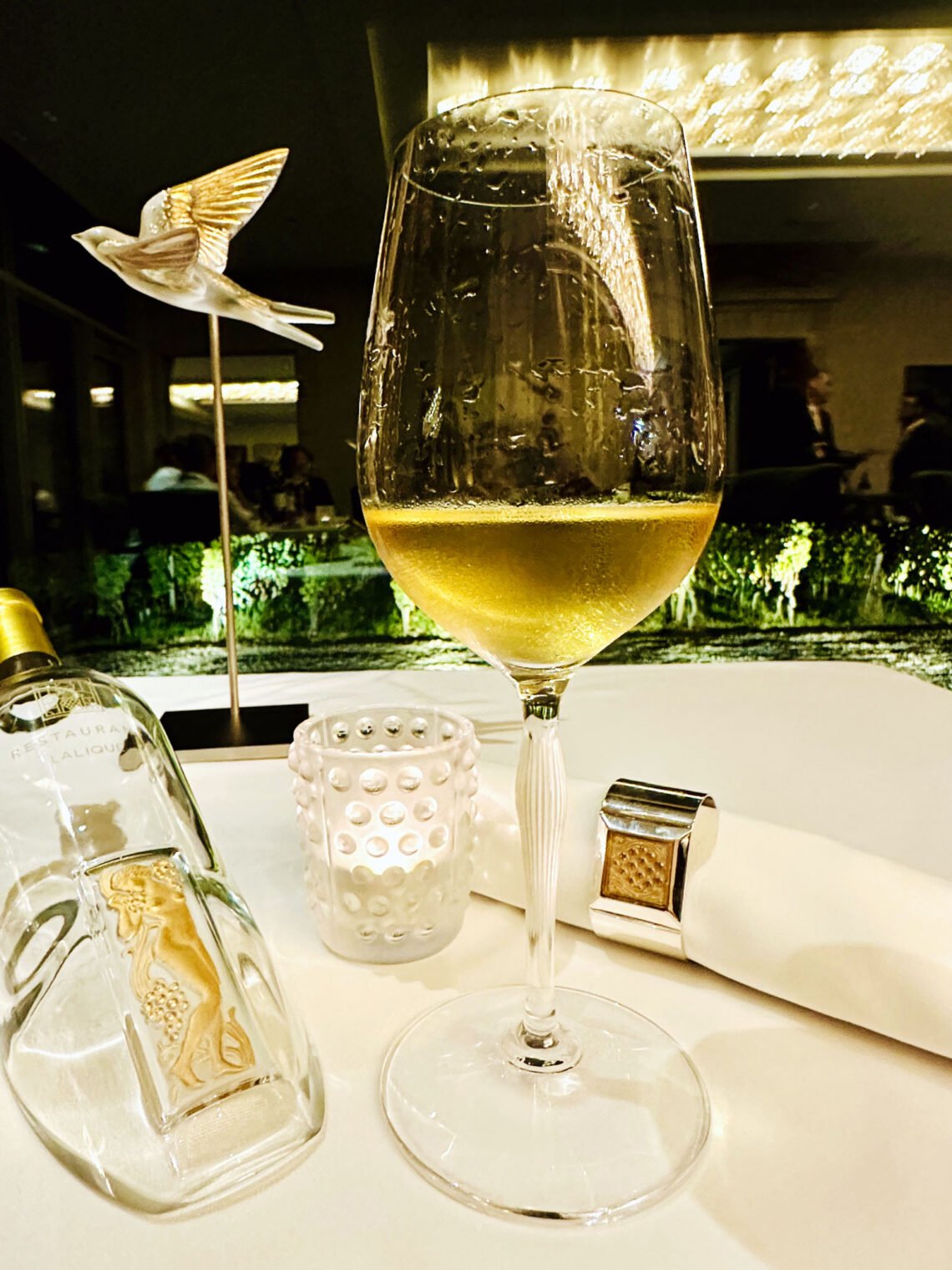
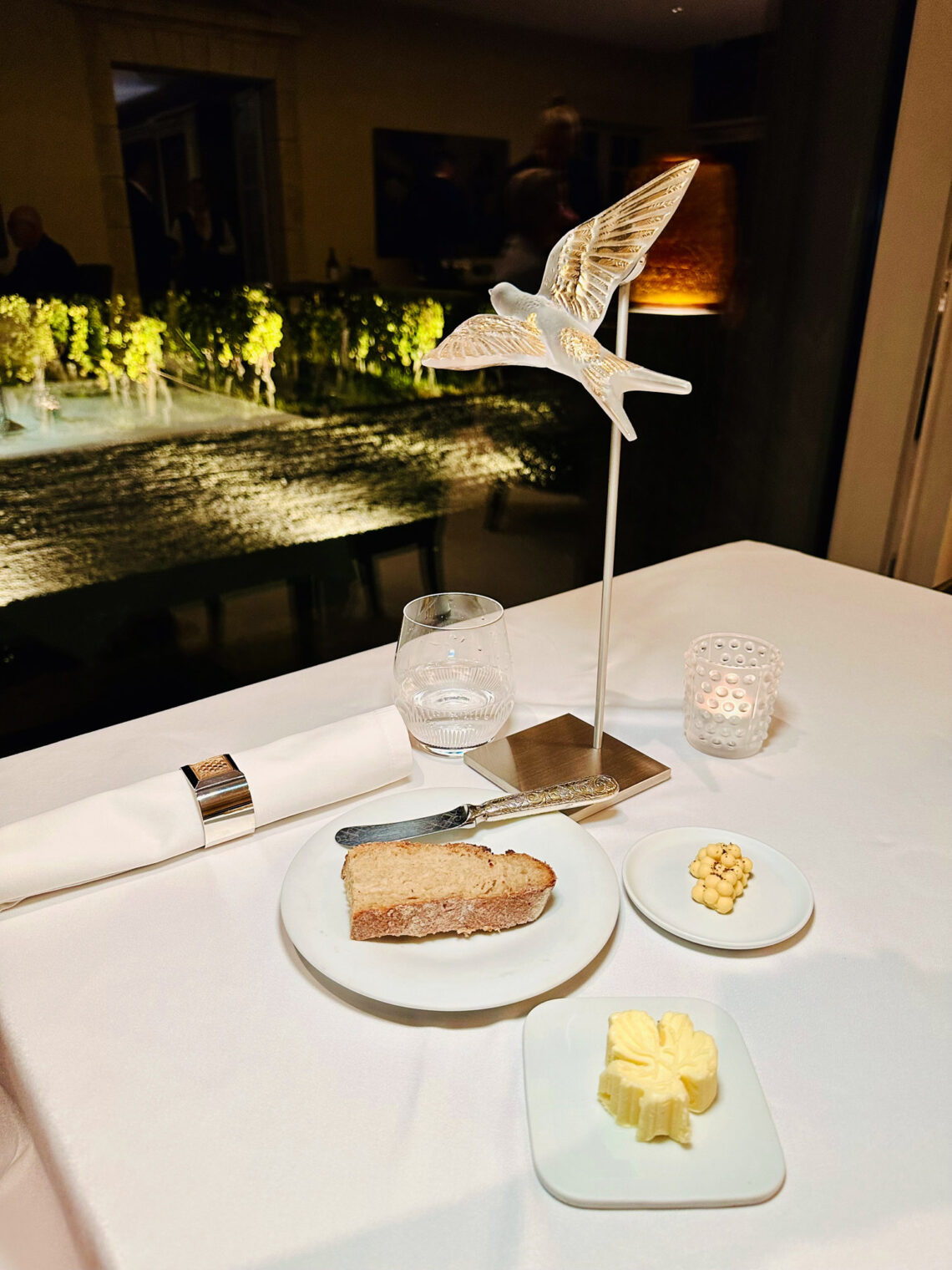
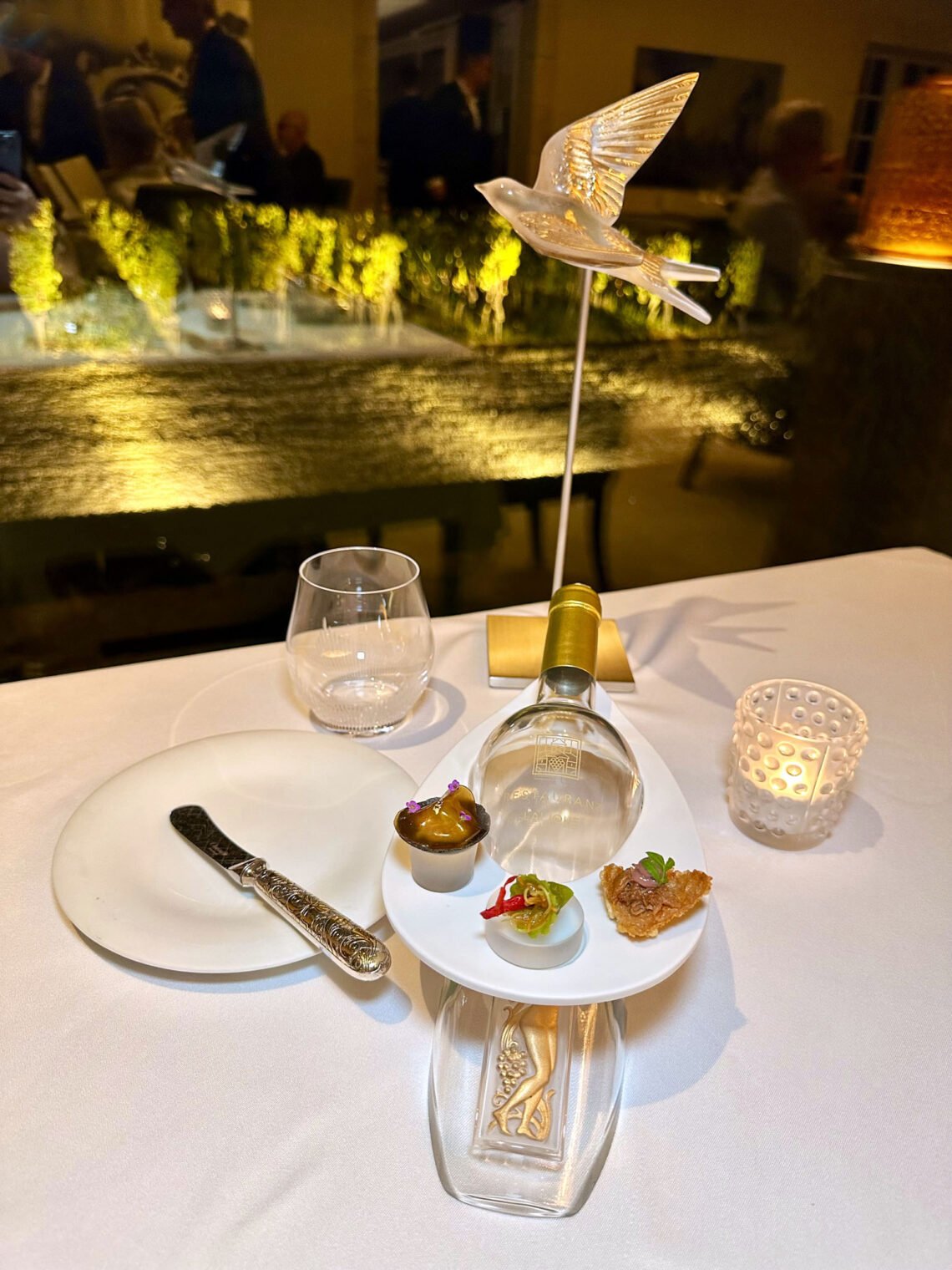
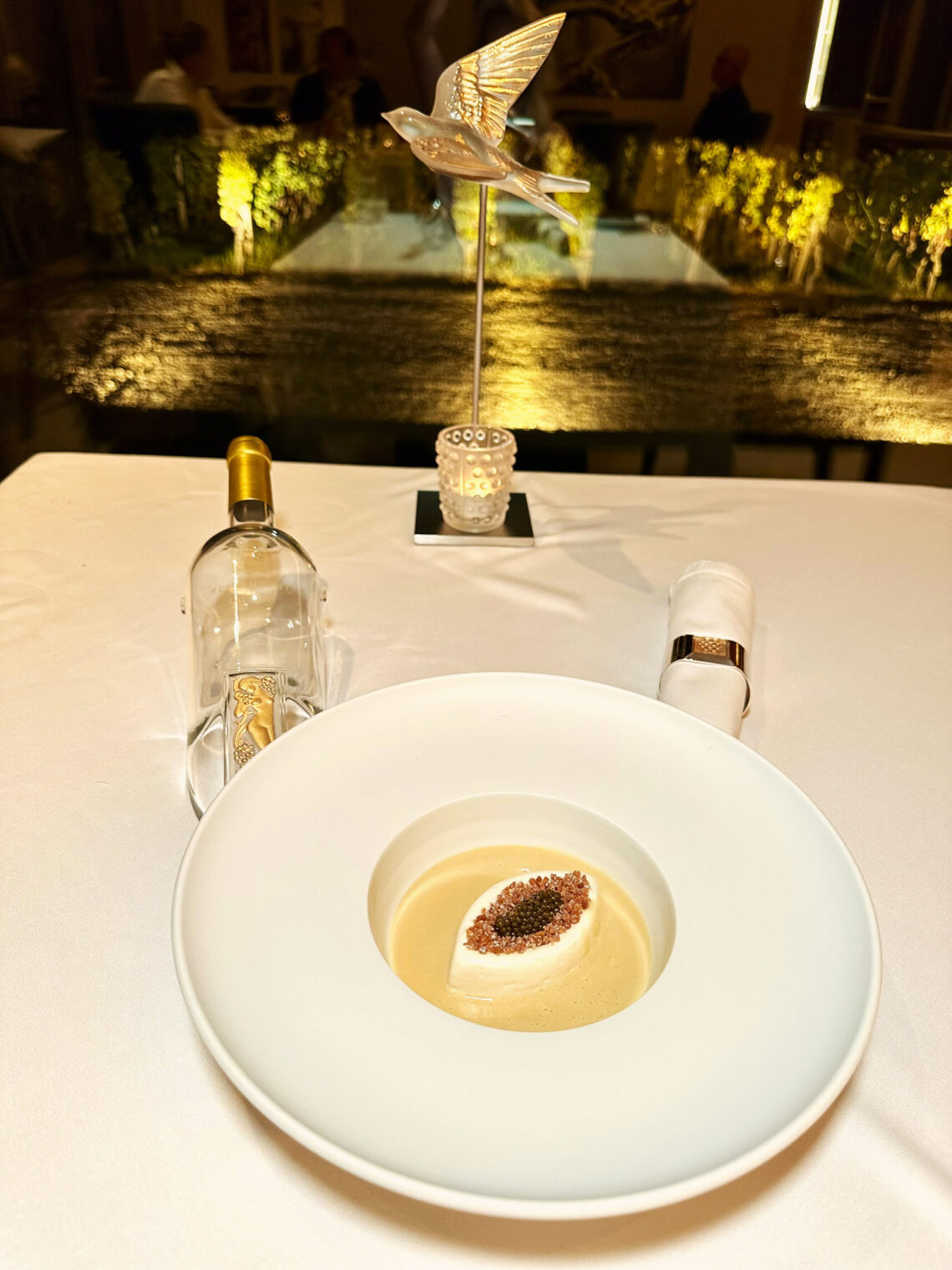
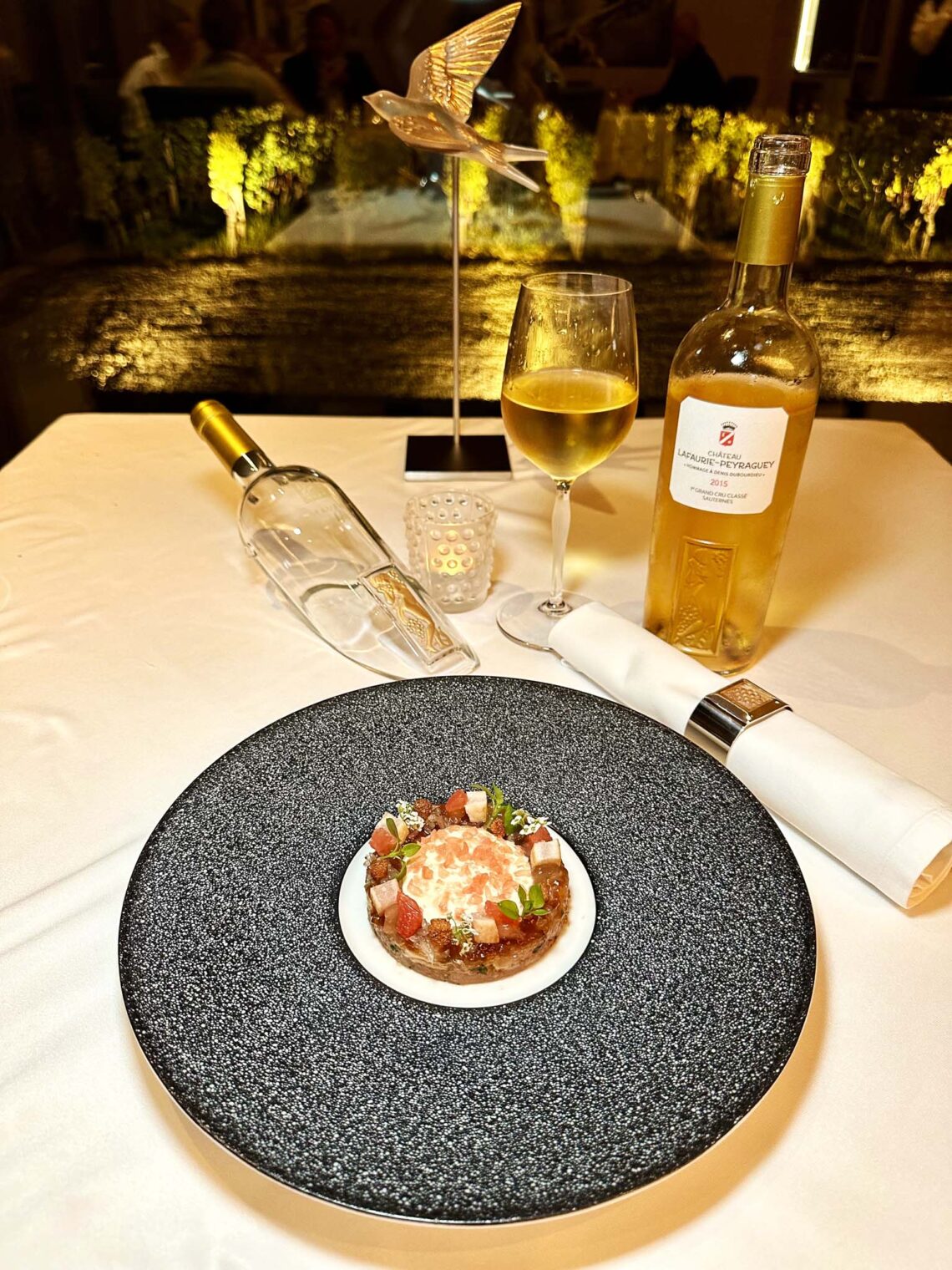
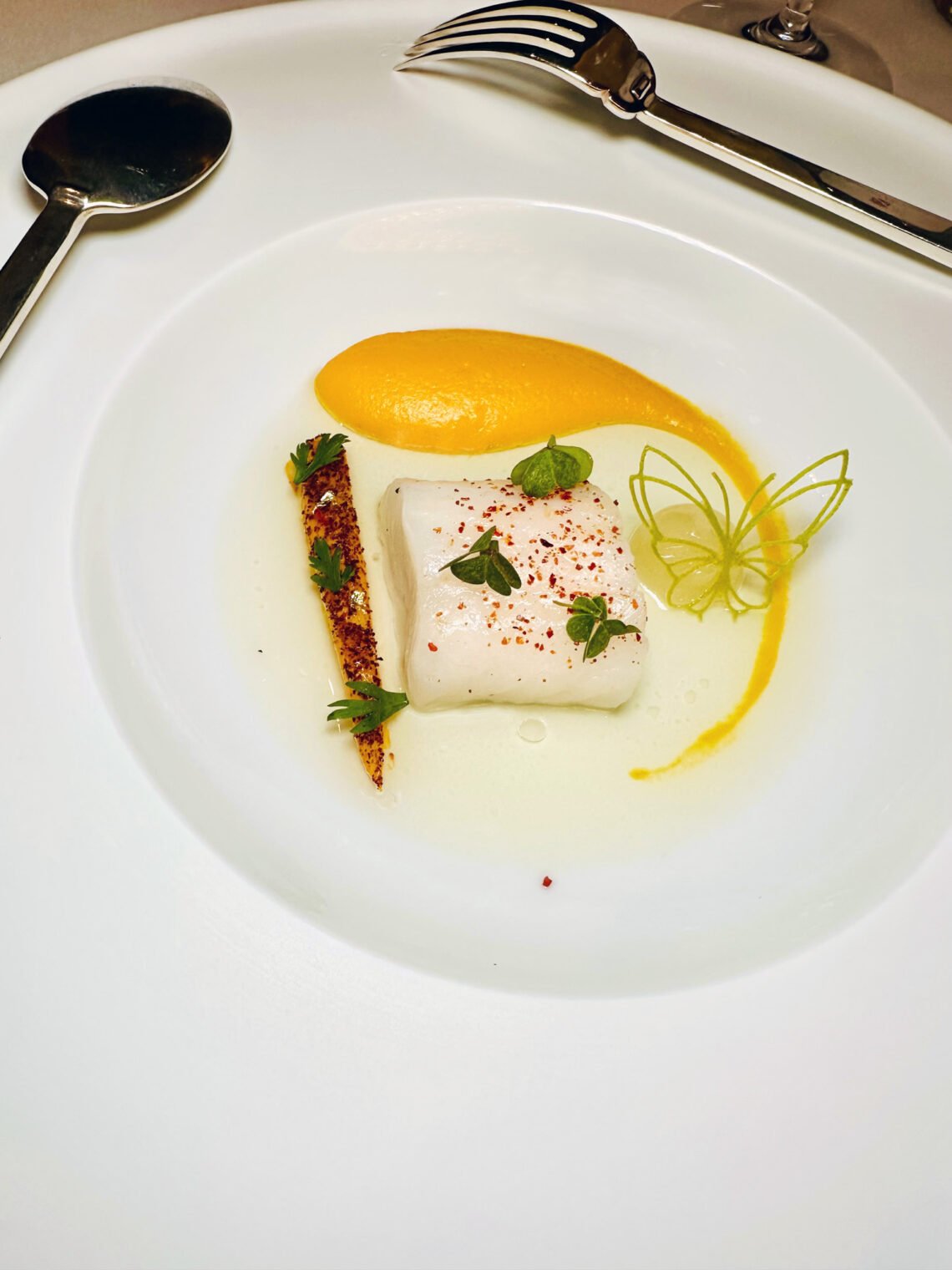
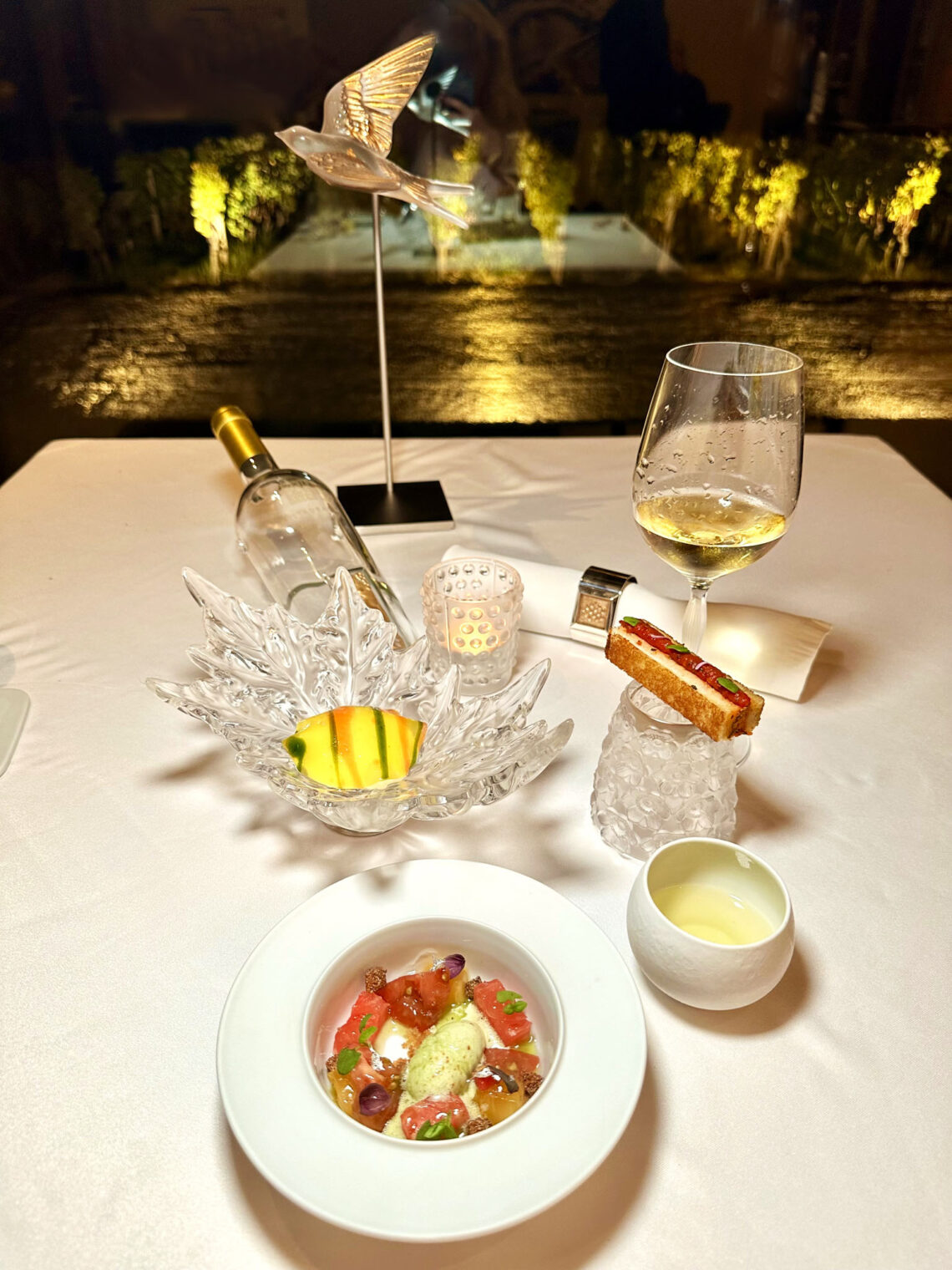
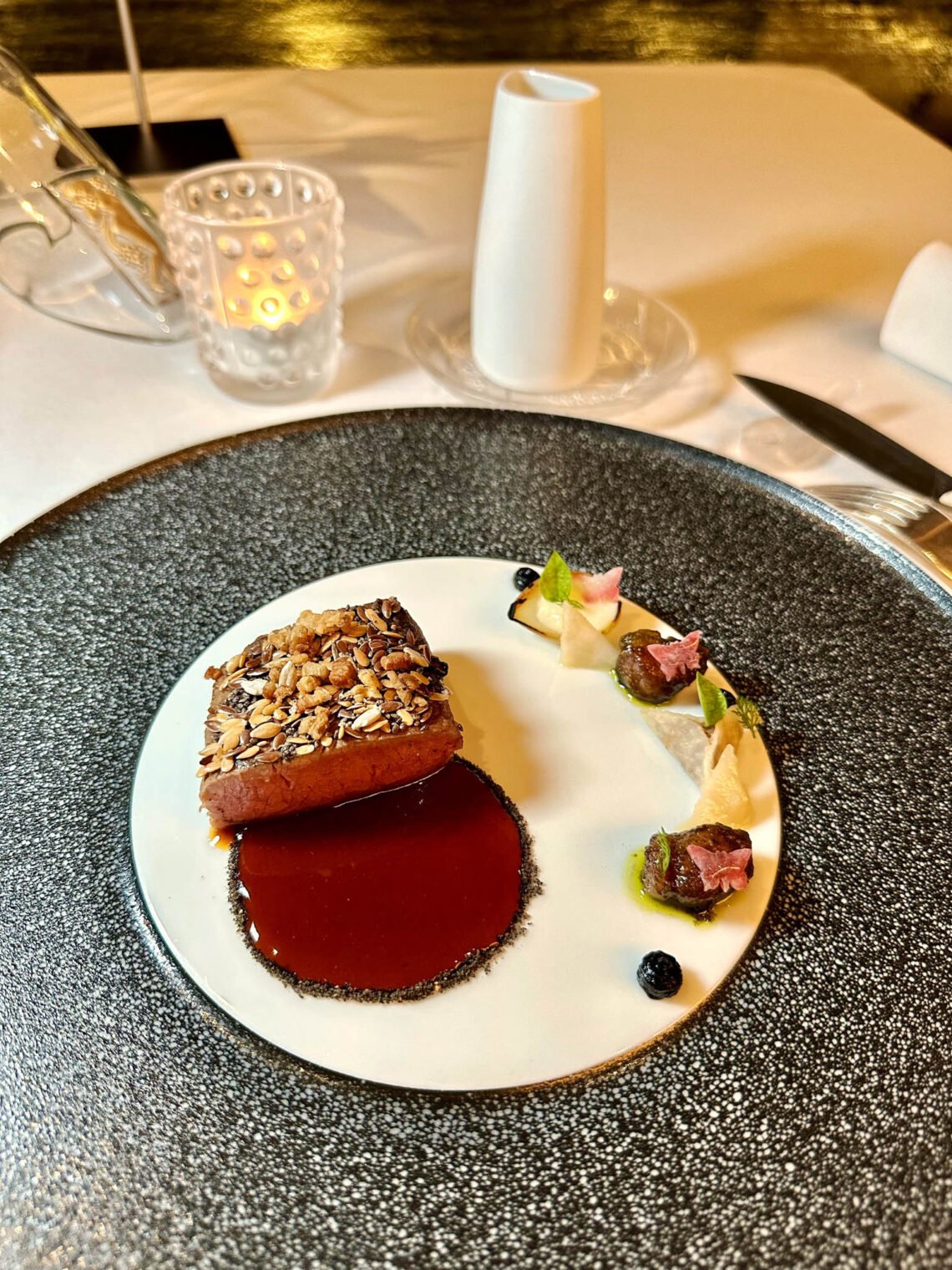
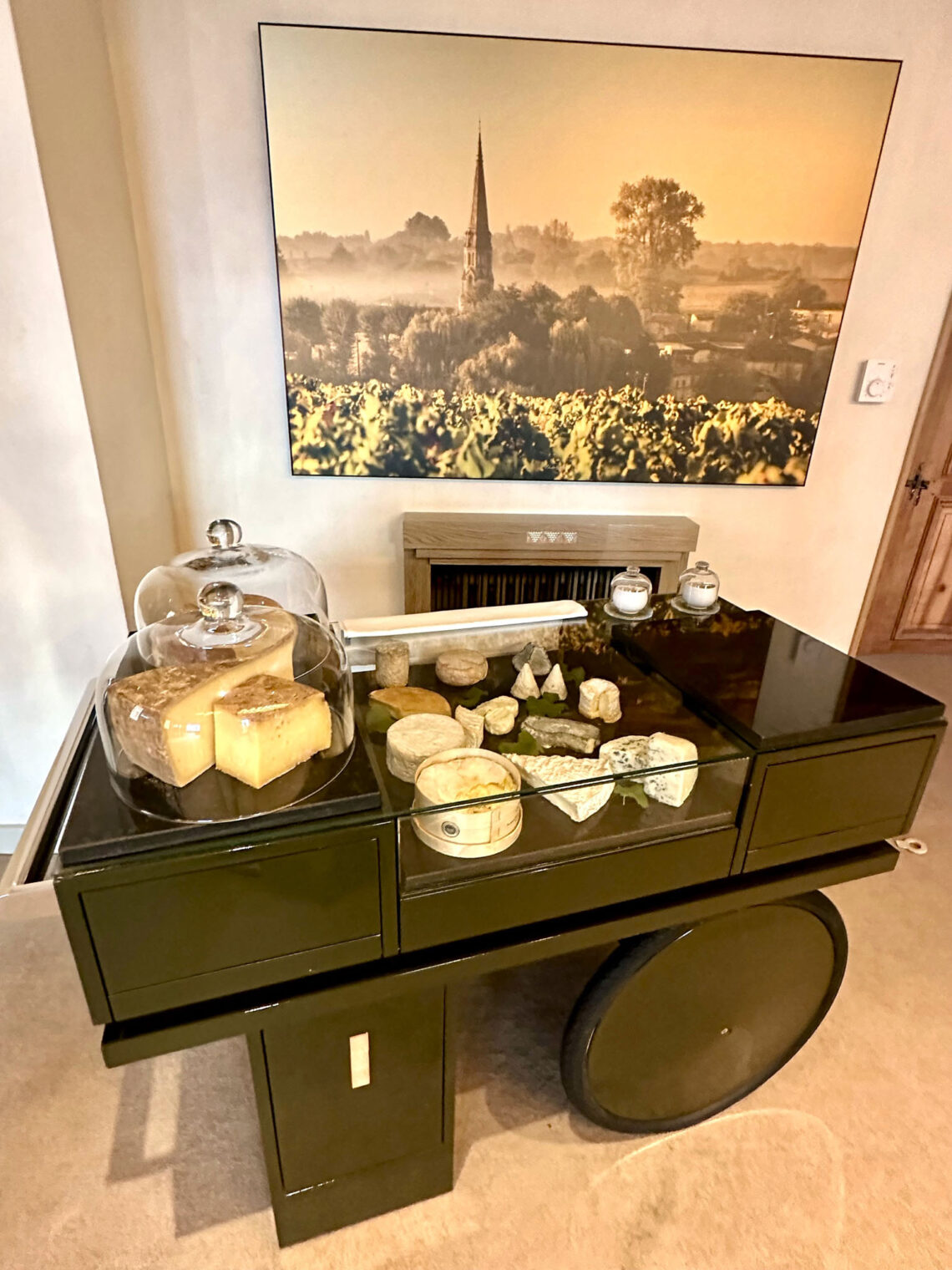
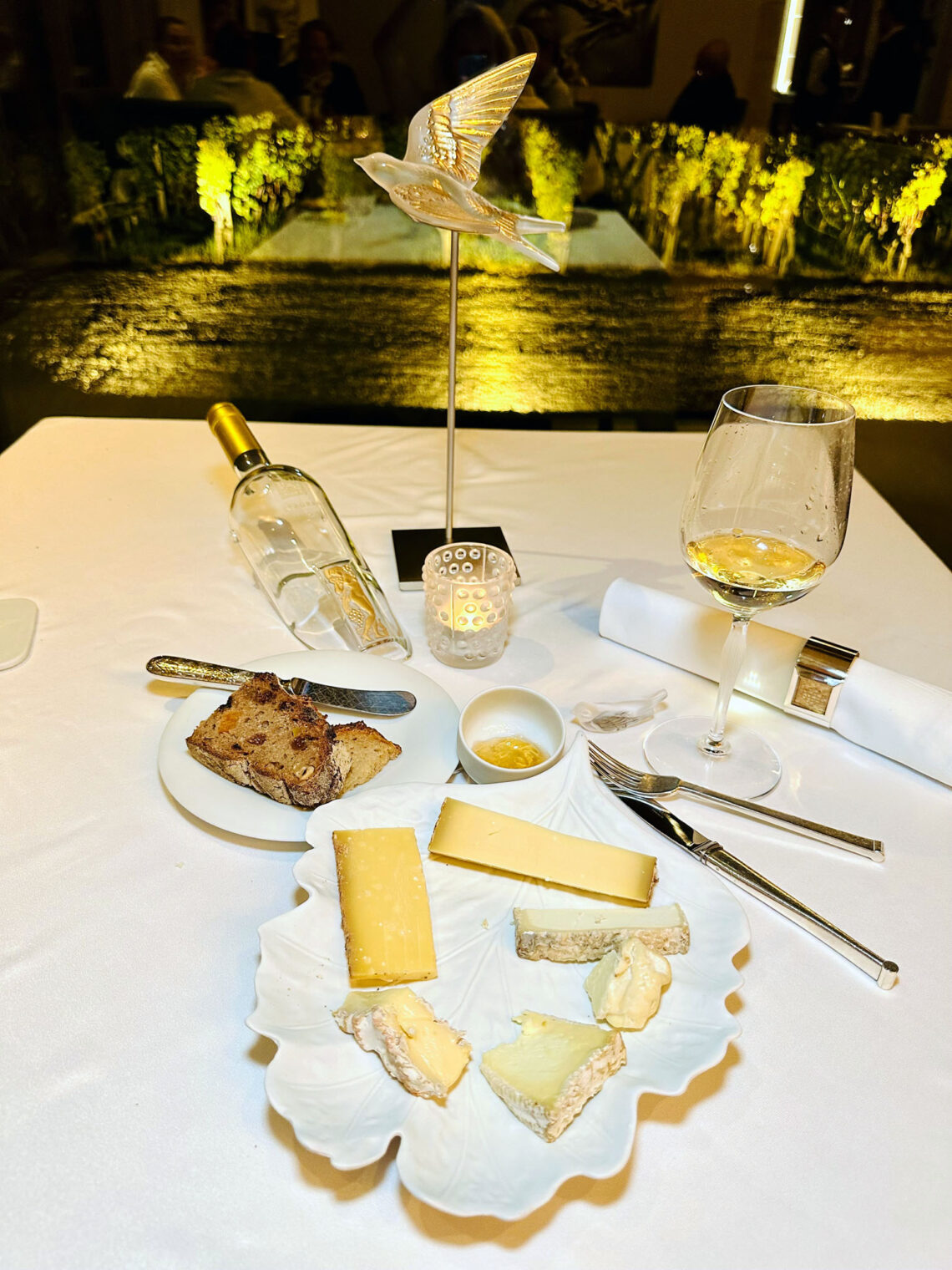
Les Desserts
The finale makes a grand entrée in a smoky Lalique bowl, mimicking the fog created by the confluence of the Ciron river and La Gironde, fog necessary for the grapes to develop the botrytis cinerea. It is a Blanc Manger, with a lemon cream, tarragon sorbet and dehydrated caviar from the Gironde. It is the perfect illustration of how pastry chef Héloïse Château likes to define her plates: “Cuisine Sucrée” (Sweet Cuisine), rather than desserts. Locally sourced blackcurrants and blackberries are paired with a Sauternes Madagascar chocolate sauce poured inside the purple ring formed by the fruit aspic. Beautiful mignardises for the curtain drop.
Even if you are not going to drink herbal tea, ask for the fresh herb cart for your viewing pleasure.

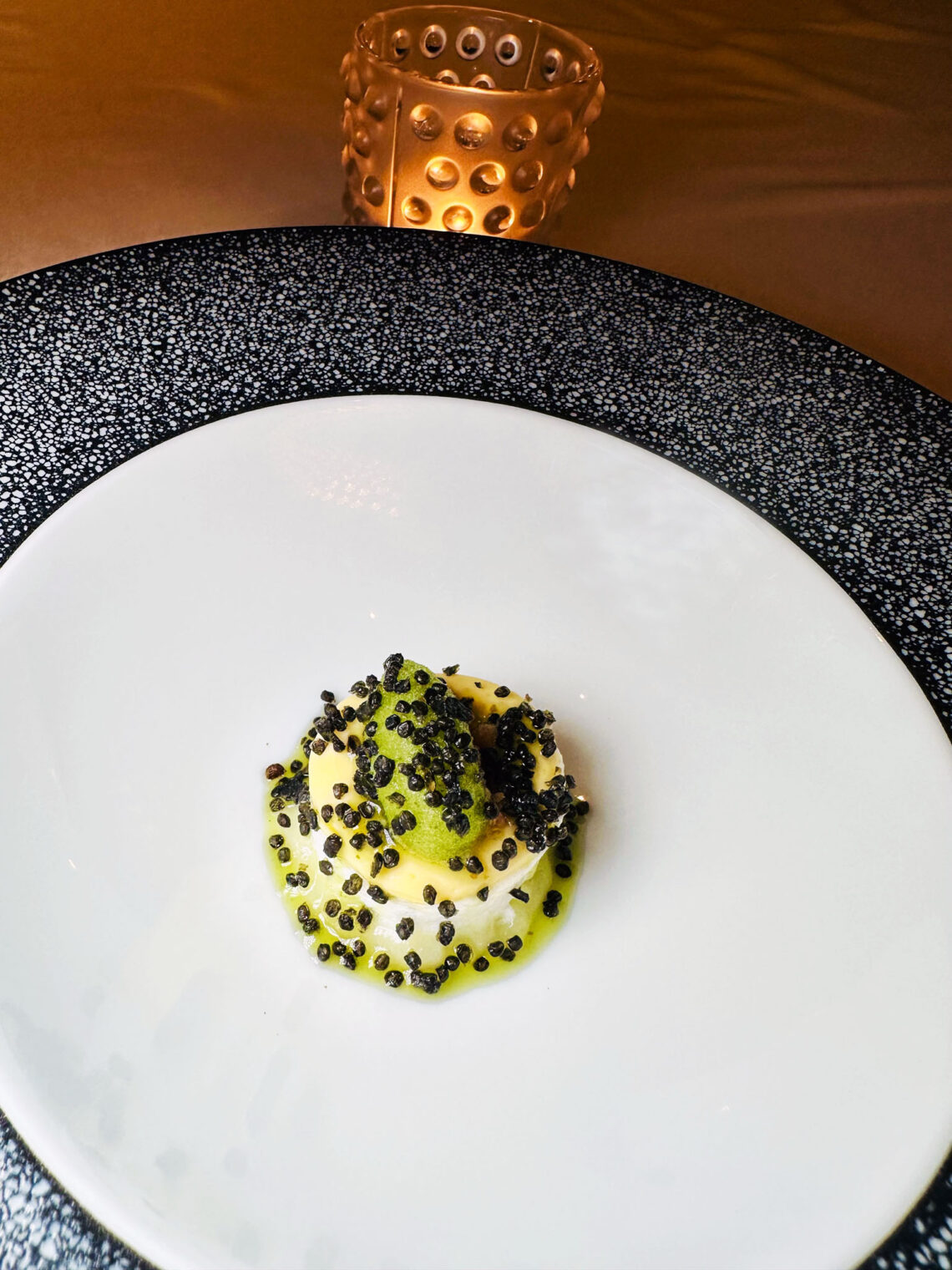
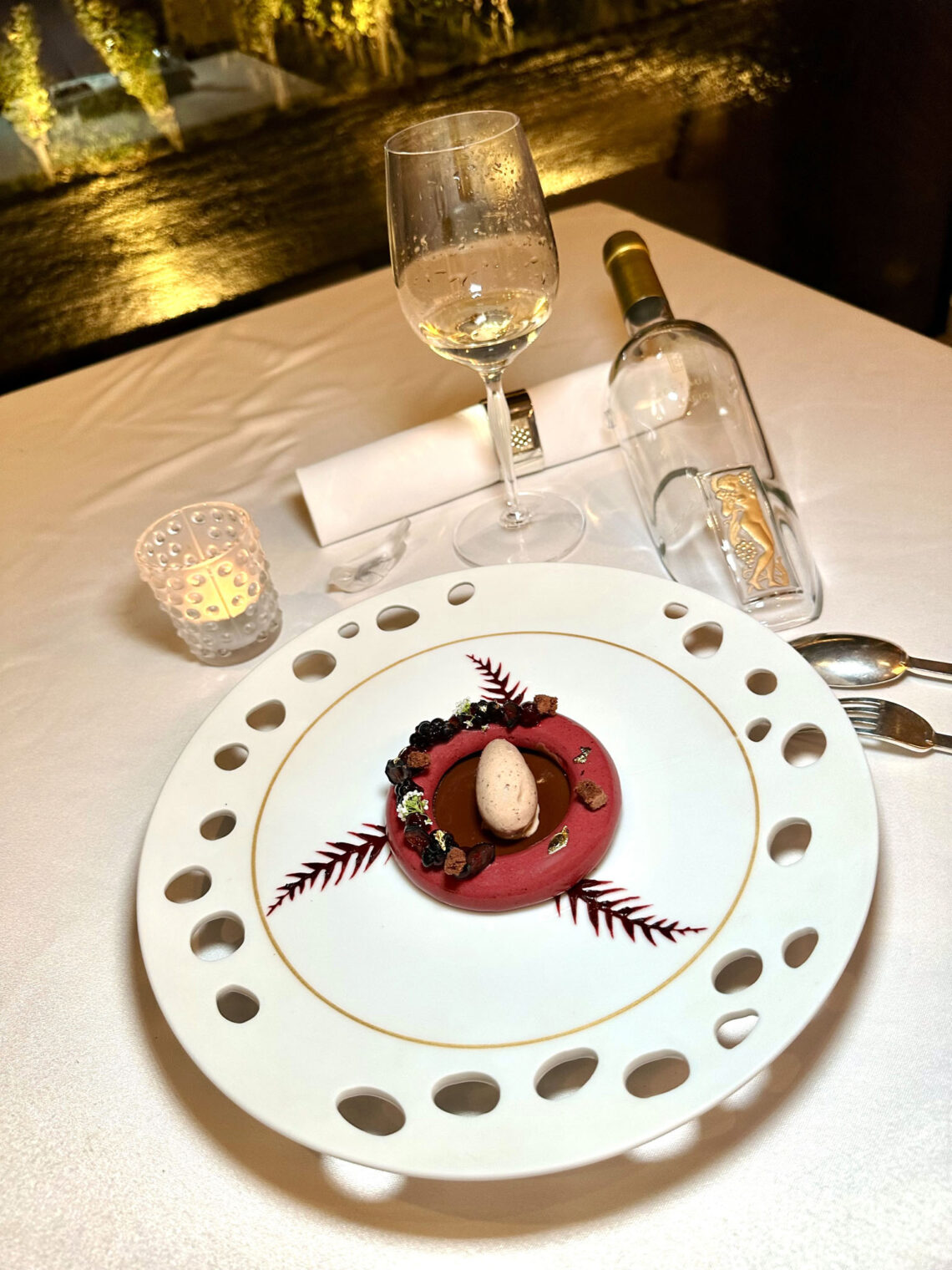
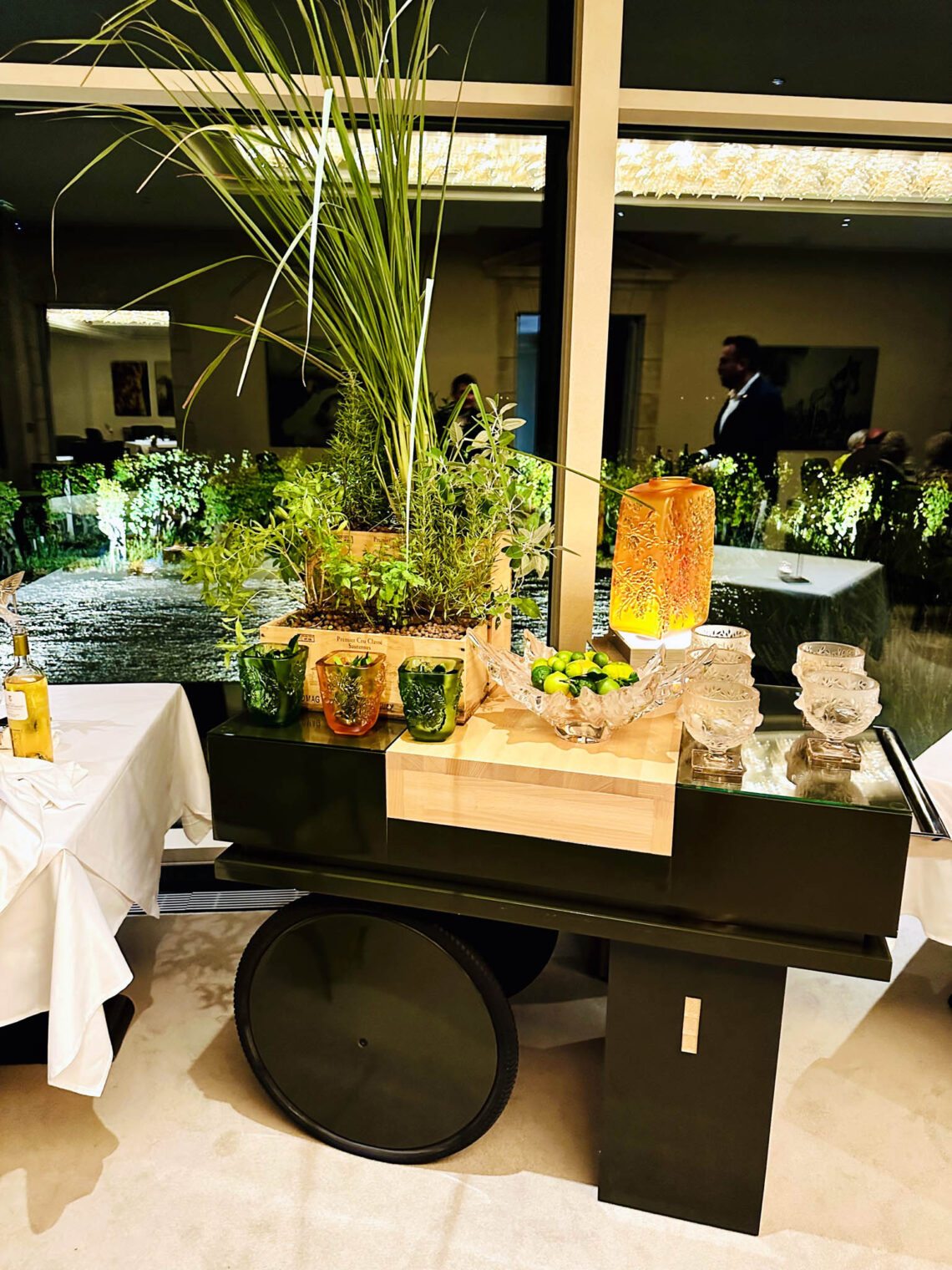
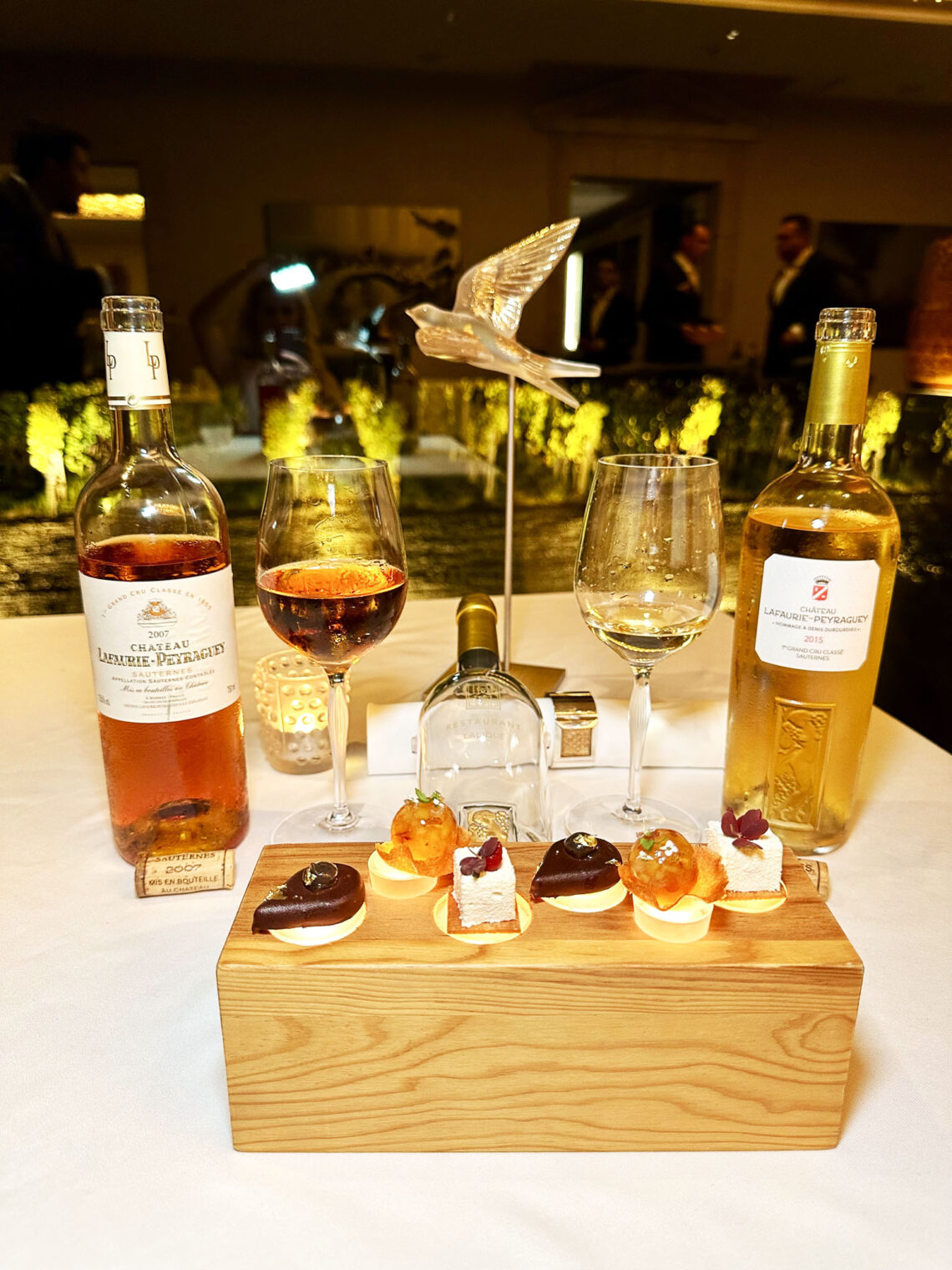
Les Vins
A haute-gastronomy restaurant in a luxury hotel, being right in the middle of the best wine region in the world, calls for an impressive wine list. Le Livre de Cave, which weighs four and half kilos and is one hundred and fourteen pages, showcases many liquid treasures, some dating back to 1895. France is represented with in a proportion of ninety percent. Red wines occupy sixty percent of the list, therefore whites are forty per cent of the selections.
A number of châteaux have a long list of verticaux. Of course, there is an emphasis on Sauternes. All the Premiers Grands Crus Classés are represented. In total, thirty thousand bottles, encompassing 2,700 labels, are stored in four underground cellars. A true dream for wine connoisseurs.
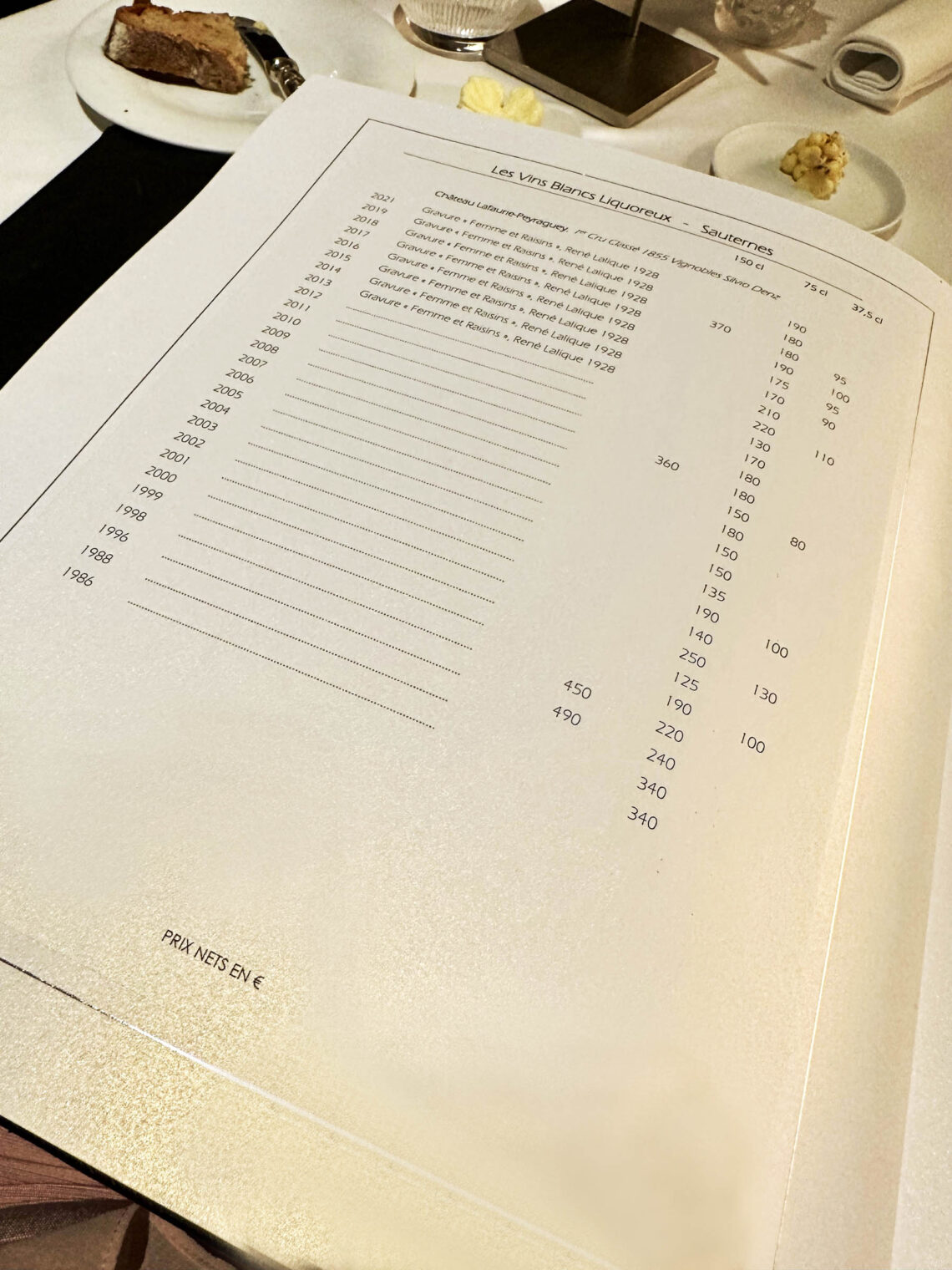
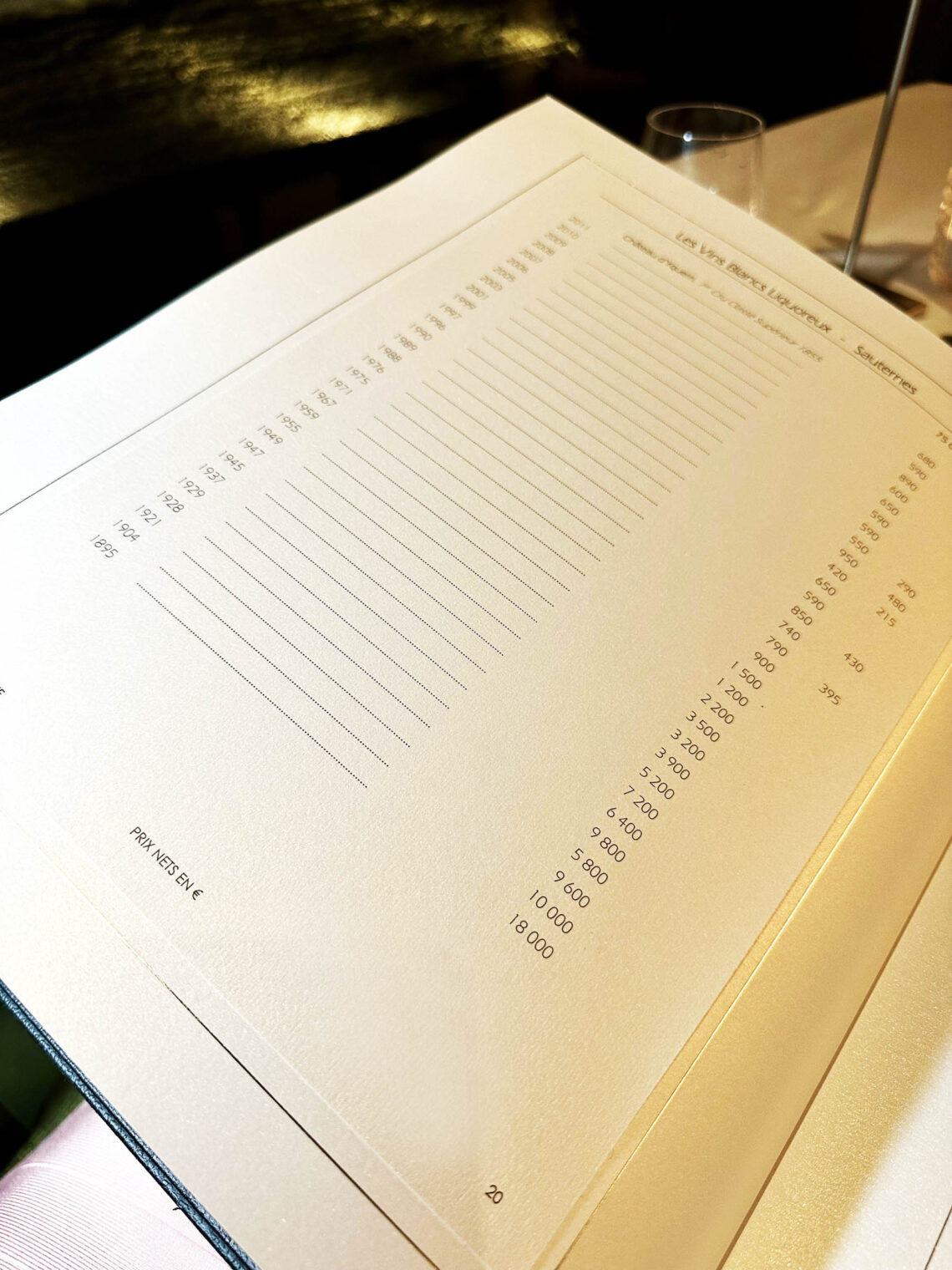
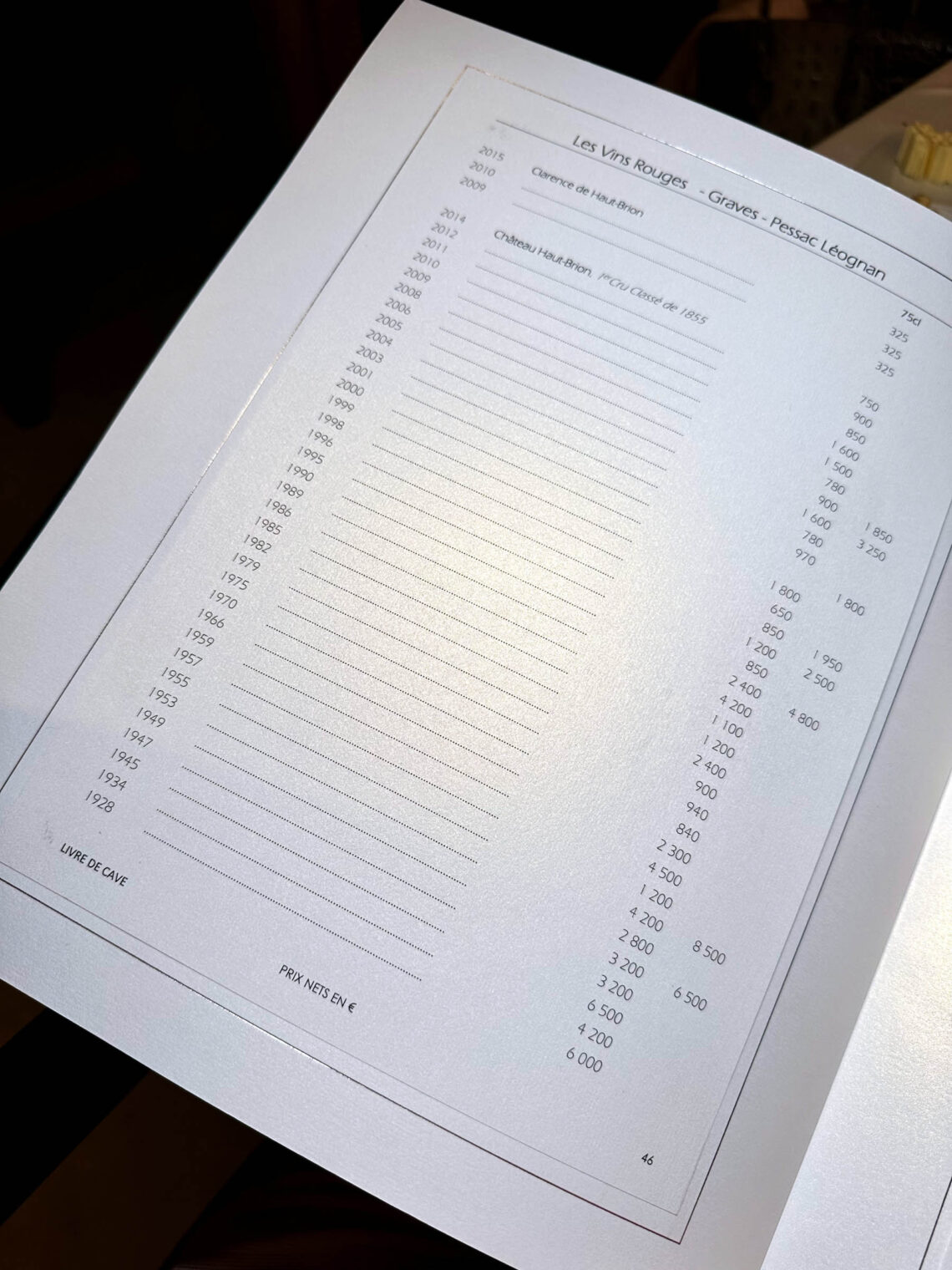
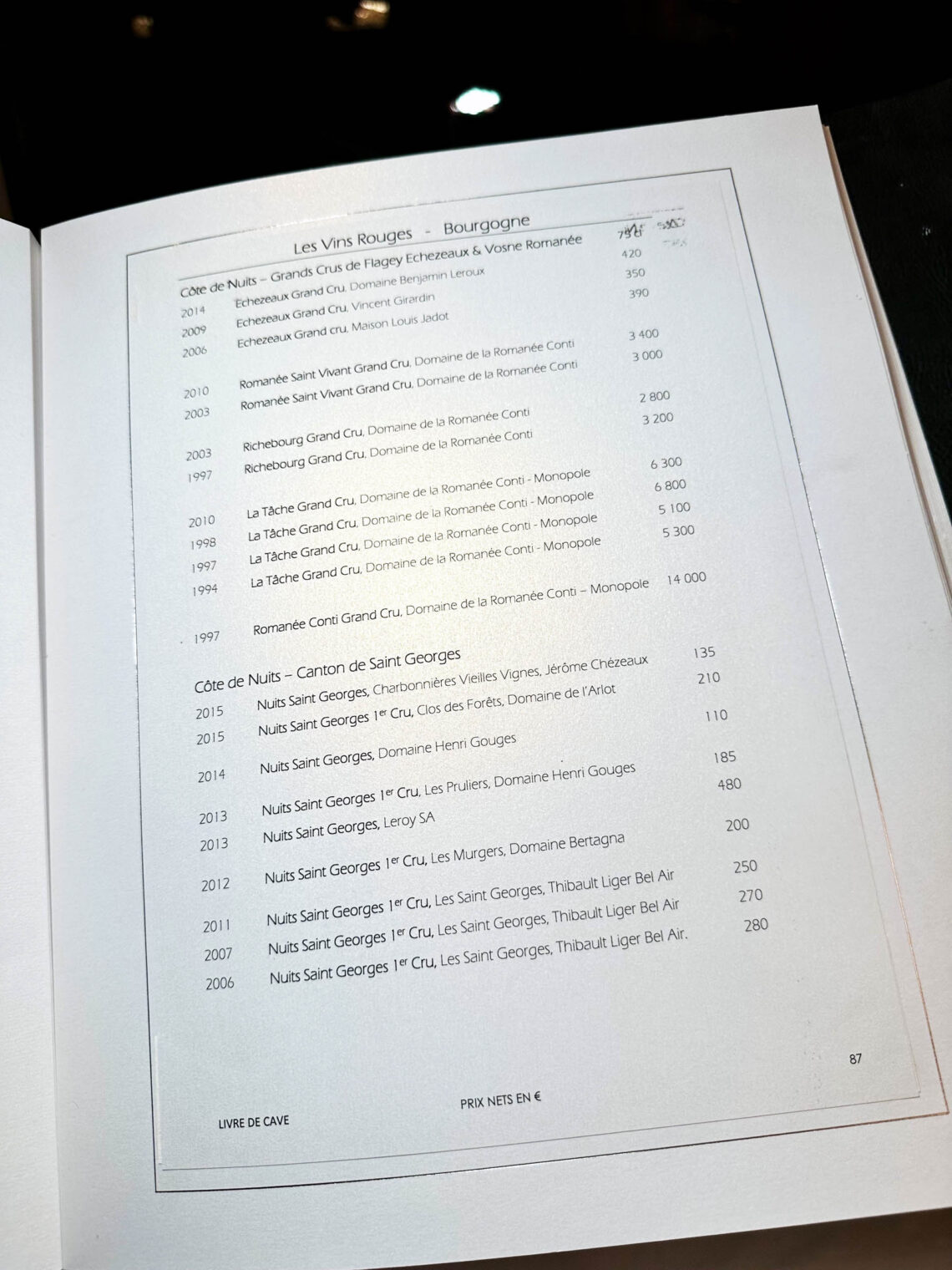
| Bordeaux Wine Official Classification of 1855 | White Wines |
|---|
| Superior First Growth | Premier Cru Supérieur |
| Château d’Yquem, Sauternes |
| First Growths | Premiers Grands Crus |
| Château La Tour Blanche, Bommes (Sauternes) |
| Château Lafaurie-Peyraguey, Bommes (Sauternes) |
| Château Clos Haut-Peyraguey, Bommes (Sauternes) |
| Château de Rayne-Vigneau, Bommes (Sauternes) |
| Château Suduiraut, Preignac (Sauternes) |
| Château Coutet, Barsac |
| Château Climens, Barsac |
| Château Guiraud, Sauternes |
| Château Rieussec, Fargues (Sauternes) |
| Château Rabaud-Promis, Bommes (Sauternes) |
| Château Sigalas-Rabaud, Bommes (Sauternes) |


